
Семь цветов Будапешта. Цвет красный. Цвет оранжевый. Начало >>>
Семь цветов Будапешта. Продолжение. Цвет желтый >>>
Цвет зеленый – парковый.
У западного вокзала Nyugati берет начало бульвар Св. Иштвана (SzentIstvdn korui), который представляет собой часть Большого бульвара (Nagy korui), полукольцом опоясавшего старый Пешт. Этот парадный проспект венгерской столицы, протяженностью почти 4,5 км, проходит по пересохшему руслу Дуная. Его задумали построить во второй половине XIX века, взяв за образец бульвар Ринг в Вене. Предлагалось даже прорыть целый судоходный канал, однако от этой идеи пришлось отказаться из-за чрезмерной дороговизны. Строительство началось в 1871 году и растянулось на четверть века. Экономический кризис и другие сложности всячески мешали реализации масштабной затеи столичных властей. В результате к 1883 году было построено всего 23 жилых дома!
Для привлечения инвесторов пришлось пойти на беспрецедентные меры, предоставив им льготный режим налогообложения. Это позволило сдвинуть процесс с мертвой точки, и темпы строительства заметно выросли. Масштаб стройки впечатляет, поскольку перепланировка затронула значительную территорию, на которой пришлось снести свыше 200 строений. Новая городская магистраль была с помпой открыта в 1896 году во время торжеств по случаю тысячелетия обретения венграми новой родины. Здесь же на одном из центральных участков бульвара в 1887 году был пущен первый в Будапеште трамвай (современные маршруты № 4 и 6).
Заканчивается бульвар у моста Маргит (Margithid), строить который начали почти одновременно с бульварным кольцом. Сложность заключалась в том, что городские власти хотели, чтобы будущий мост не просто связал два берега реки, но также имел бы съезд на остров Маргит (напротив поворота к острову сделан балкон, с которого открывается великолепный вид на Дунай и прибрежные кварталы.
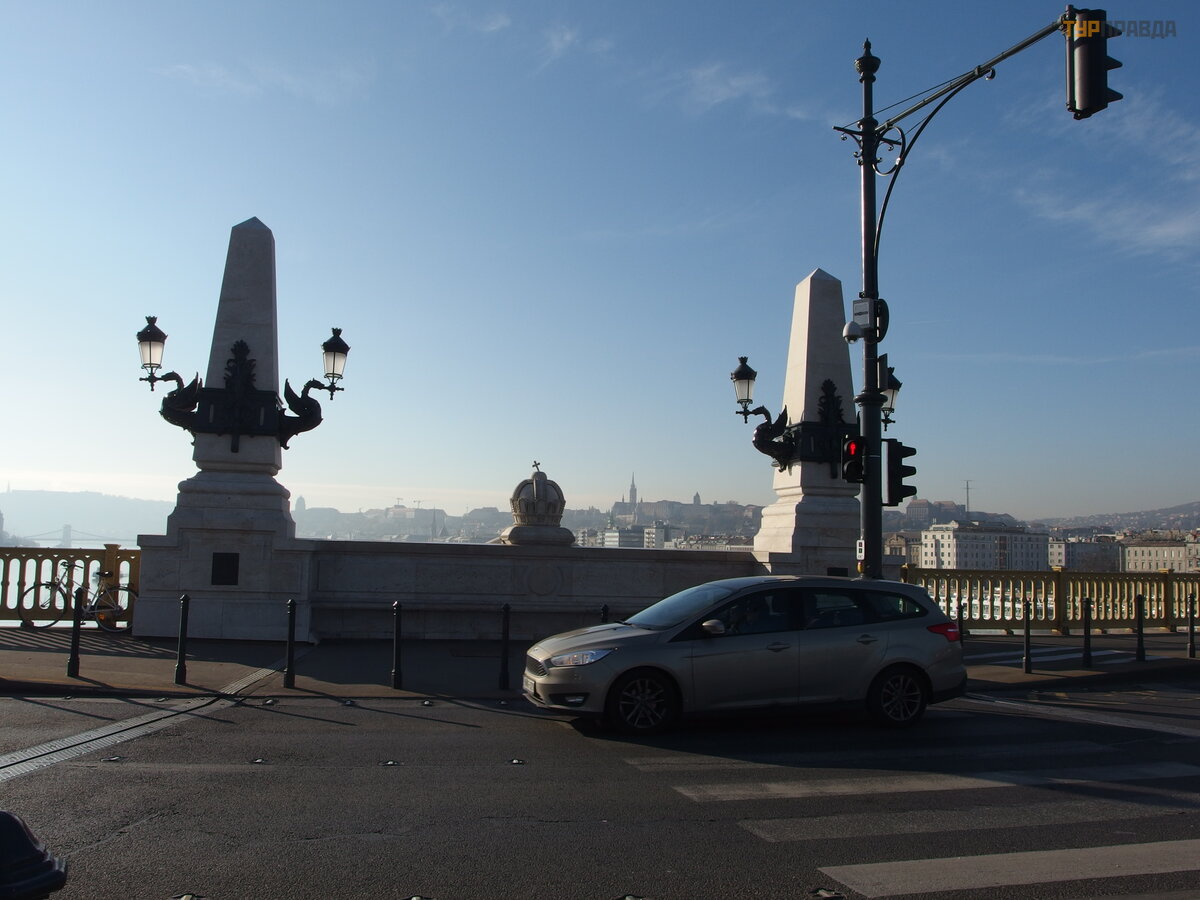
Конкурс на строительство моста выиграла французская компания. Это отразилось и на облике сооружения, напоминавшего парижские мосты. К сожалению, многие элементы оформления, включая ажурные кованые ограждения и фонари, не сохранились. Лишь ростры кораблей на опорах напоминают о былой красоте. Мост часто приходилось перестраивать, каждый раз расширяя проезжую часть под нужды растущего города. После войны его и вовсе пришлось восстанавливать из руин, поскольку, как и все другие переправы, он был взорван отступавшими гитлеровцами. Последняя реконструкция началась в 2009-2011 году. За это время планировалось не только заменить износившиеся конструкции, но и вернуть прежние элементы оформления.
С мостом Маргит связано немало городских легенд. Он стал любимым местом городских самоубийц, что вдохновило поэта Яноша Араня сочинить балладу, посвященную самоубийцам, которую проиллюстрировал известный художник Михай Зичи (был придворным художником российского двора, иллюстрировал произведения Лермонтова, Гоголя, известен иллюстрациями к поэме Шота Руставели "Витязь в тигровой шкуре").
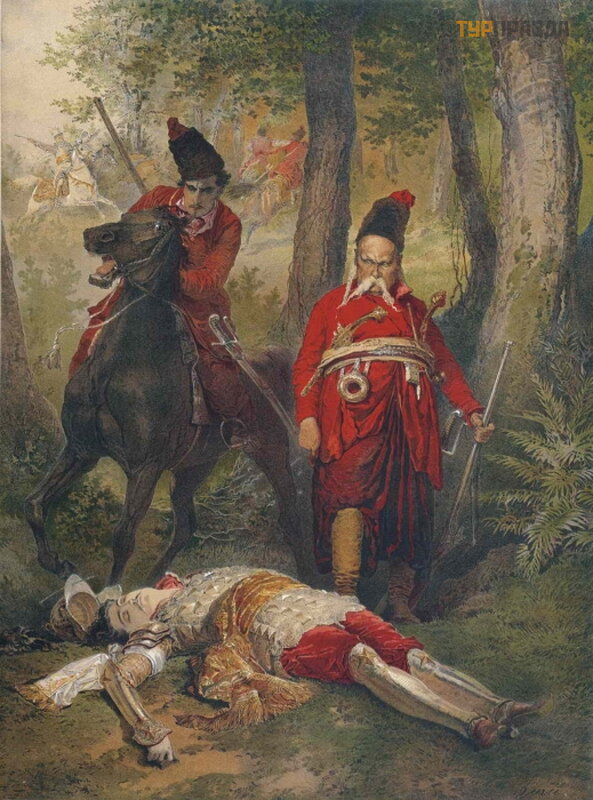 Тарас Бульба
Тарас Бульба
Бюст художника установлен на острове.
Остров Маргит (Маргитсигет, венгр. Margitsziget) представляет собой городской парк, который признан самым красивым парком Будапешта. Состоит остров Маргит из трех небольших островков. До того, как была укреплена северная сторона, которая сегодня упирается в мост Арпада (Arpad Hid), он медленно двигался вниз по течению. Длина острова Маргит – 2,5 км. Первоначально площадь острова Маргит составляла 58 га, сегодняшние размеры острова – 96,5 га, наибольшая ширина – 500 м. Раньше остров находился на высоте 102,5 м над уровнем моря, однако из-за частых подтоплений его подняли еще на 2 м. В прошлом будапештский остров на Дунае, состоящий из галечных отложений, в течение многих лет намытых рекой, был известен под разными именами: остров господ, заячий остров, остров святого Андраша, девичий остров, будайский остров, остров Палатинус и пр. Сегодняшнее свое название – Margit Sziget – он получил в 14 веке благодаря расположенному на острове женскому доминиканскому монастырю. Монастырь и церковь построил король Венгрии Бела IV для своей дочери Маргариты.
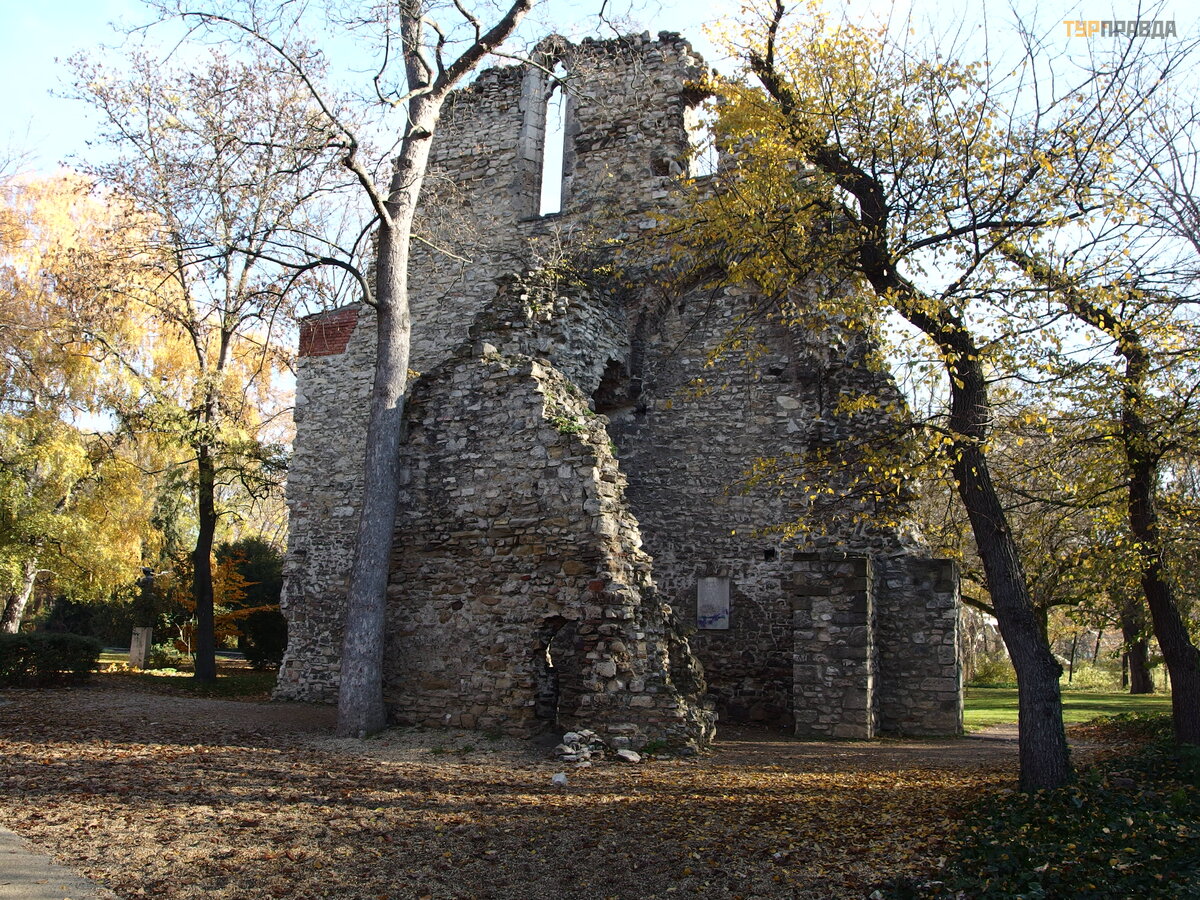 Руины доминиканского монастыря на острове
Руины доминиканского монастыря на острове
Еще в 1241 году, до рождения дочери (родилась в 1242 году), Бела IV поклялся перед всевышним отдать ему на служение своего ребенка, если тот поможет отразить нападение монголо-татар и спасти венгерский народ. Судя по всему, бог внял молитвам короля, поскольку нашествие врагов удалось отбить. По возвращении в Венгрию (временно король пребывал в Австрии) Маргариту отдали на воспитание монахиням. Тогда девочке было всего 9 лет. В стенах доминиканского монастыря она выросла, затем стала настоятельницей. Известно, что монахини этого монастыря вели необычайно аскетический образ жизни. К сожалению, умерла Маргарита очень рано – в 29 лет. После смерти ее объявили святой, а позднее и сам остров назвали в честь девушки.
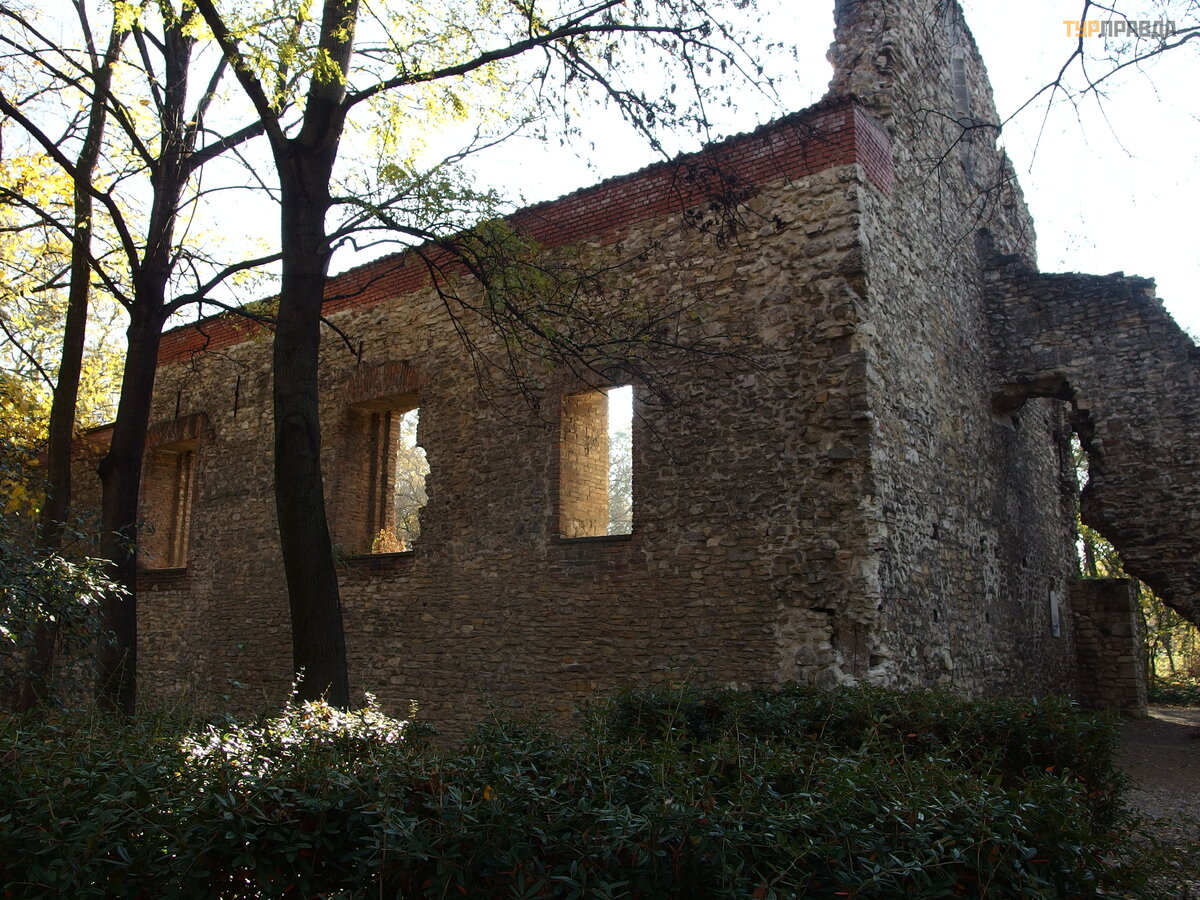 Церковь и связанный с ней монастырь стояли прямо на восточном побережье острова. Наиболее сохранившиеся части монастырских построек
Церковь и связанный с ней монастырь стояли прямо на восточном побережье острова. Наиболее сохранившиеся части монастырских построек
В 1540 году монастырь был оставлен монахинями, которые забрали с собой останки Святой Маргит. В 1541 году доминиканский монастырь разрушили и разграбили турки. Известно, что они использовали монастырские стены для размещения здесь гарема паши… Почти то же :)))
В 1796 году остров отошел к палатину (наместнику) Иосифу (Йожефу), который занимал этот пост на протяжении полувека. Йожеф прославился как большой любитель садов. Он построил здесь для своей супруги, русской княгини Александры Павловны, виллу и разбил парк с роскошным розарием. Для ландшафтного оформления острова был приглашен молодой садовник Карой Тошт (ему было всего 20 лет), выходец из известной династии садовников из Шонбрунна. Приехав в Венгрию в 1810 году, Карой остался здесь навсегда. Многое из того, что мы имеем возможность видеть сегодня на острове Маргит, – это дело его рук.
При палатине Йожифе на острове было высажено около 300 видов растений. В том числе, впервые были высажены платаны, в дальнейшем превосходно прижившиеся на острове Маргит и сохранившиеся до сих пор.
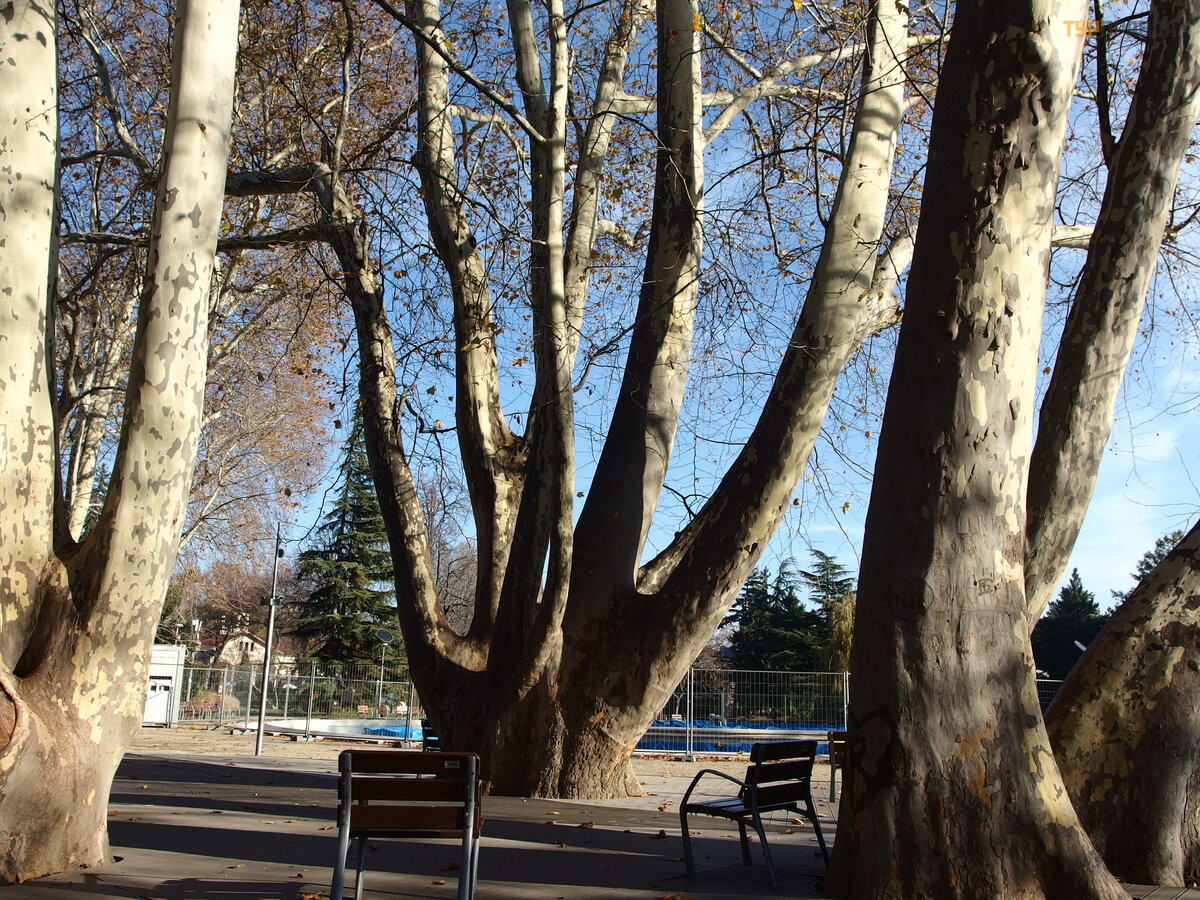 Те самые платаны
Те самые платаны
В 1869 году парк открыли для публики. Однако вплоть до 1908 года его разрешалось посещать исключительно по входным билетам. С 1882 года главным садовником острова Маргит был Дьердь Мадьяр (1844-1923 гг.). Сохранились сведения, что при нем на острове выращивалось с коммерческой целью невероятное количество роз: 1400 сортов.
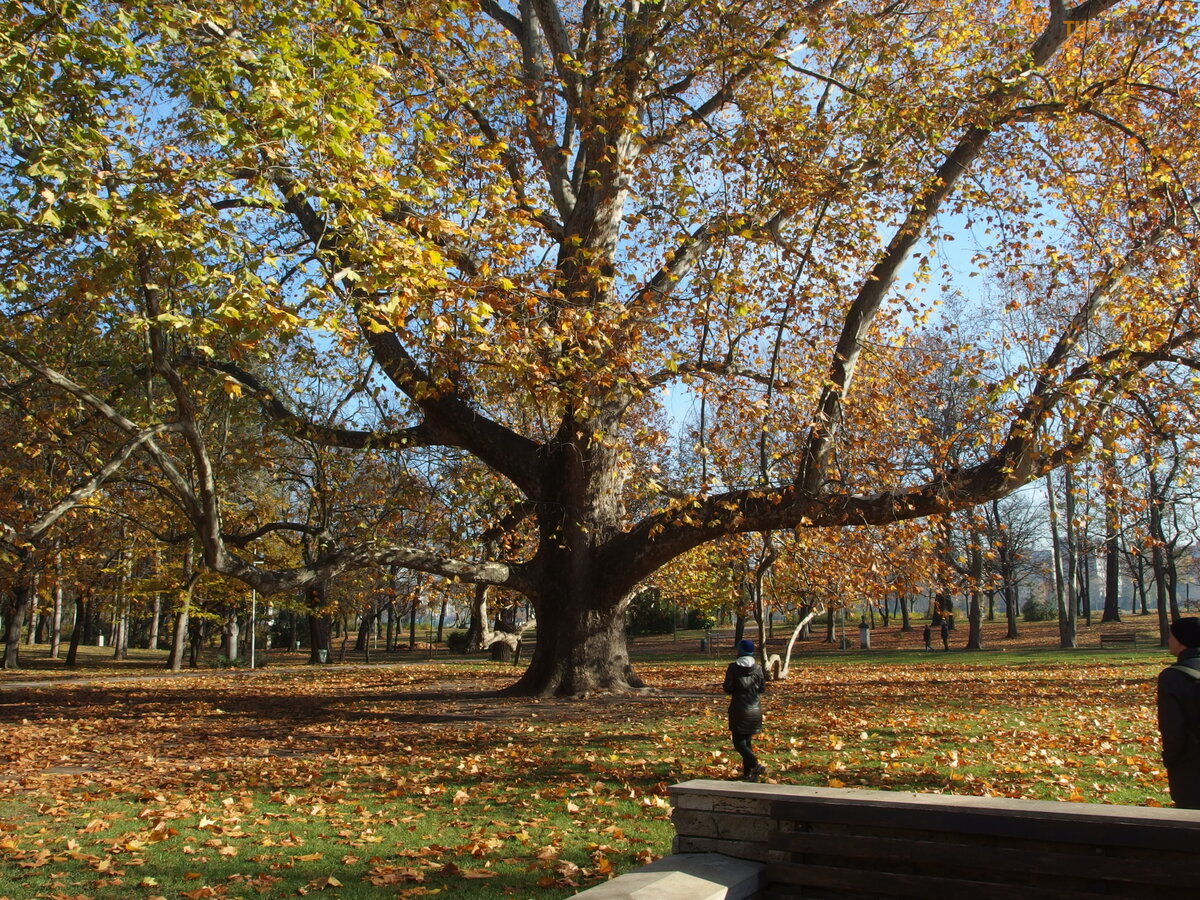
Парк на острове Маргит стал излюбленным местом отдыха для местных жителей еще во второй половине 19 века. Правда, вплоть до 1901 года на остров можно было добраться только по реке на лодках и кораблях. Мост Маргариты построили в 1876 году по проекту французского инженера Эрнеста Гуина, но лишь четверть века спустя к нему пристроили съезд на остров.
Нынешний облик острова Маргит в основном был сформирован в середине 19 столетия, но и на 20 век пришлись серьезные преобразования. В частности в 1911 году были созданы новые прогулочные зоны. После 1927 года в ходе работ по созданию парка были обработаны 60 тысяч куб. м земли, проведены прогулочные дорожки длиной 6 тысяч м и шириной 6 м. На пештской стороне острова высадили 150 ясеней, а на будайской – 200 елей. Кроме них были высажены еще 3 тысячи прочих деревьев и 50 тысяч растений. На месте садоводческого центра был разбит огромный цветник, занимающий площадь 15 тысяч кв. м!
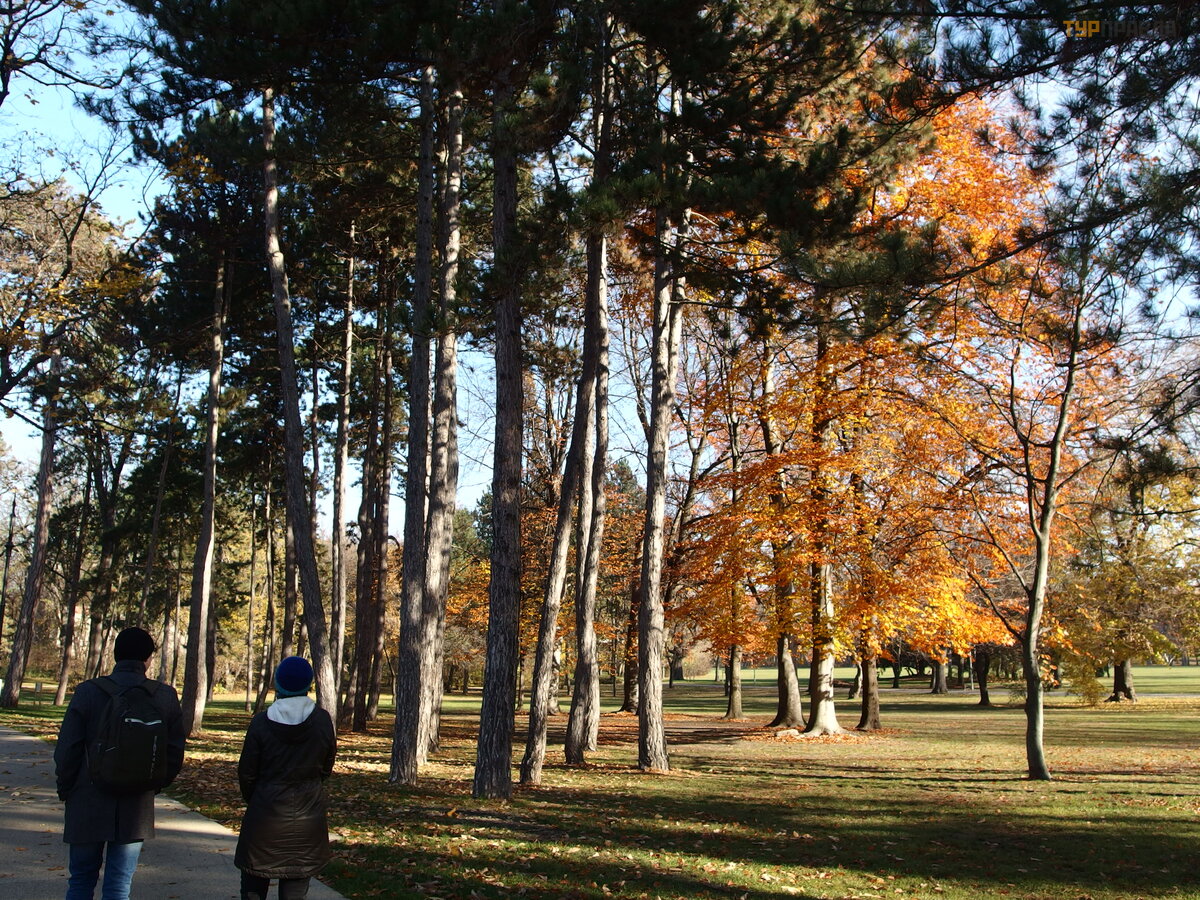
Начиная с 1866 года, когда при бурении скважины были обнаружены артезианские целебные воды, остров Маргит прославился как термальный курорт. Официальный статус санатория остров получил в 1929 году. Сейчас на его территории бьют три термальных источника с лечебной минеральной водой.
У моста Маргариты начинается центральная аллея острова. Здесь в 1972 году был установлен памятник в ознаменование 100-летней годовщины присоединения Буды и Пешта и Обуды в 1873 году. Этот бронзовый монумент, разработанный Иштваном Киссом, представляет собой два переплетшихся листа.
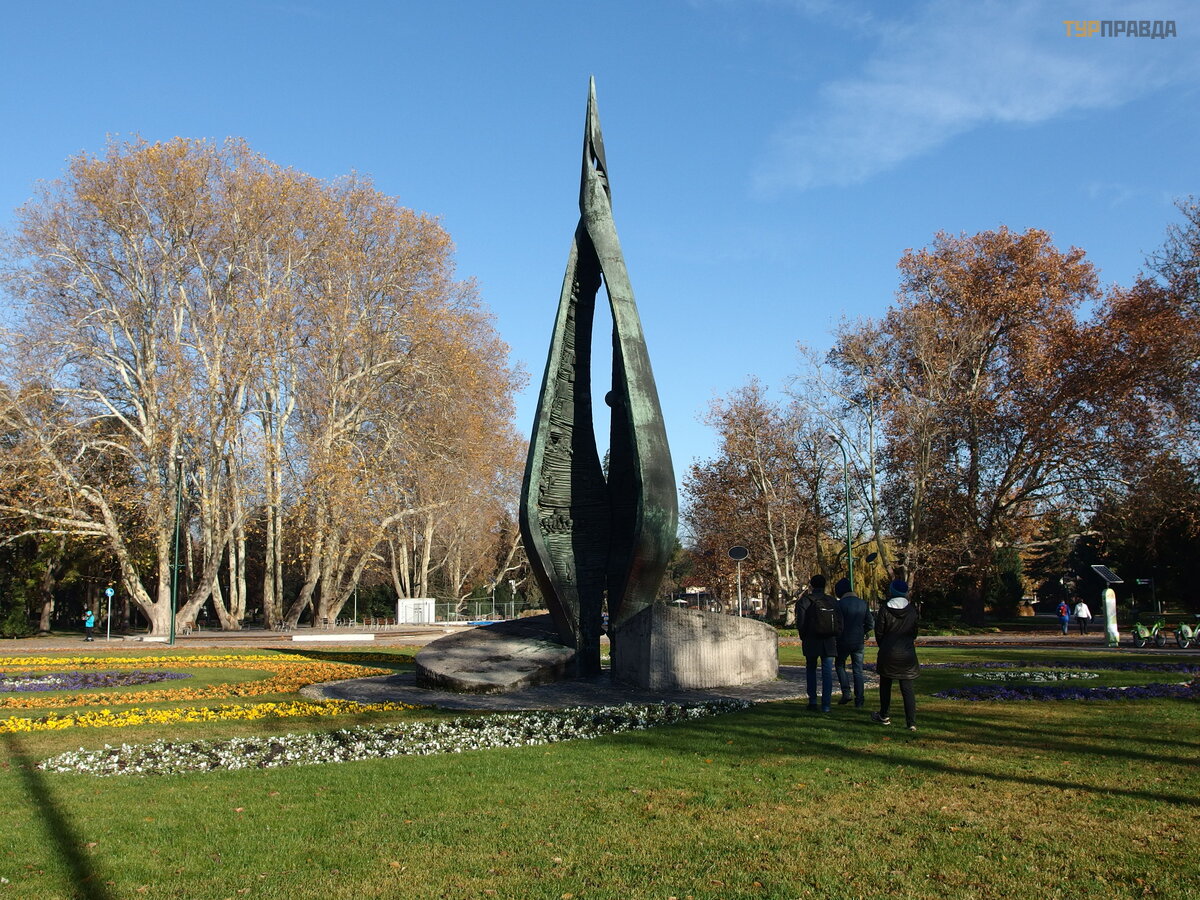
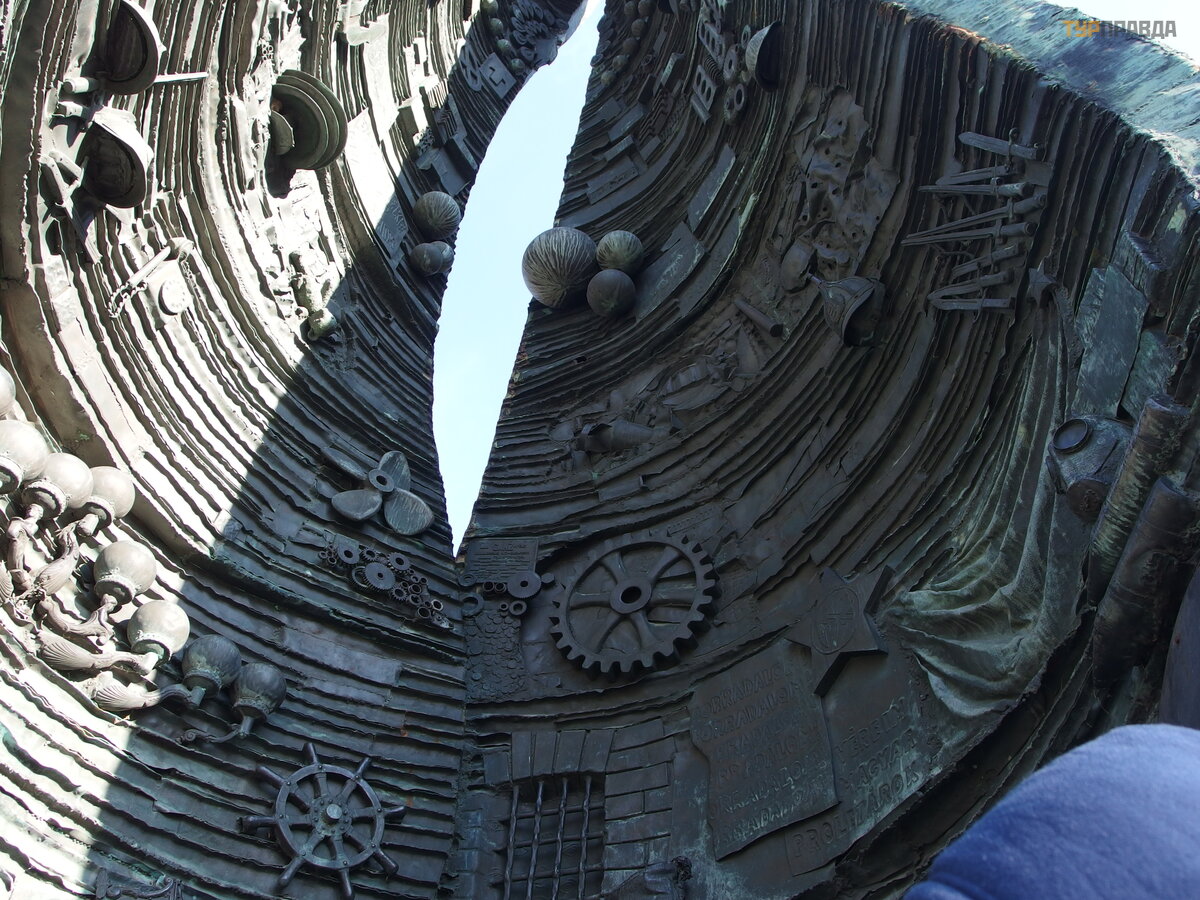
Напротив памятника расположен большой «музыкальный фонтан», струи которого постоянно меняют размеры и форму. По вечерам разыгрывается настоящее свето-музыкальное представление: под музыку включается яркая подсветка.
В центре острова Маргарит справа от главной аллеи можно увидеть одну из основных местных достопримечательностей – развалины францисканской церкви 14 века. Недалеко от развалин располагается вилла палатина Йожефа. Вернее, тоже развалины, поскольку вилла была уничтожена еще в 1838 году вследствие наводнения.
В летнее время на острове открыт самый большой пляж Будапешта – «Палантинус».
Еще одна достопримечательность острова Маргит – 57-метровая водонапорная башня, увенчанная куполом. Ее заметно издалека из разных уголков острова. В здании башни сегодня проводятся выставки современного искусства.
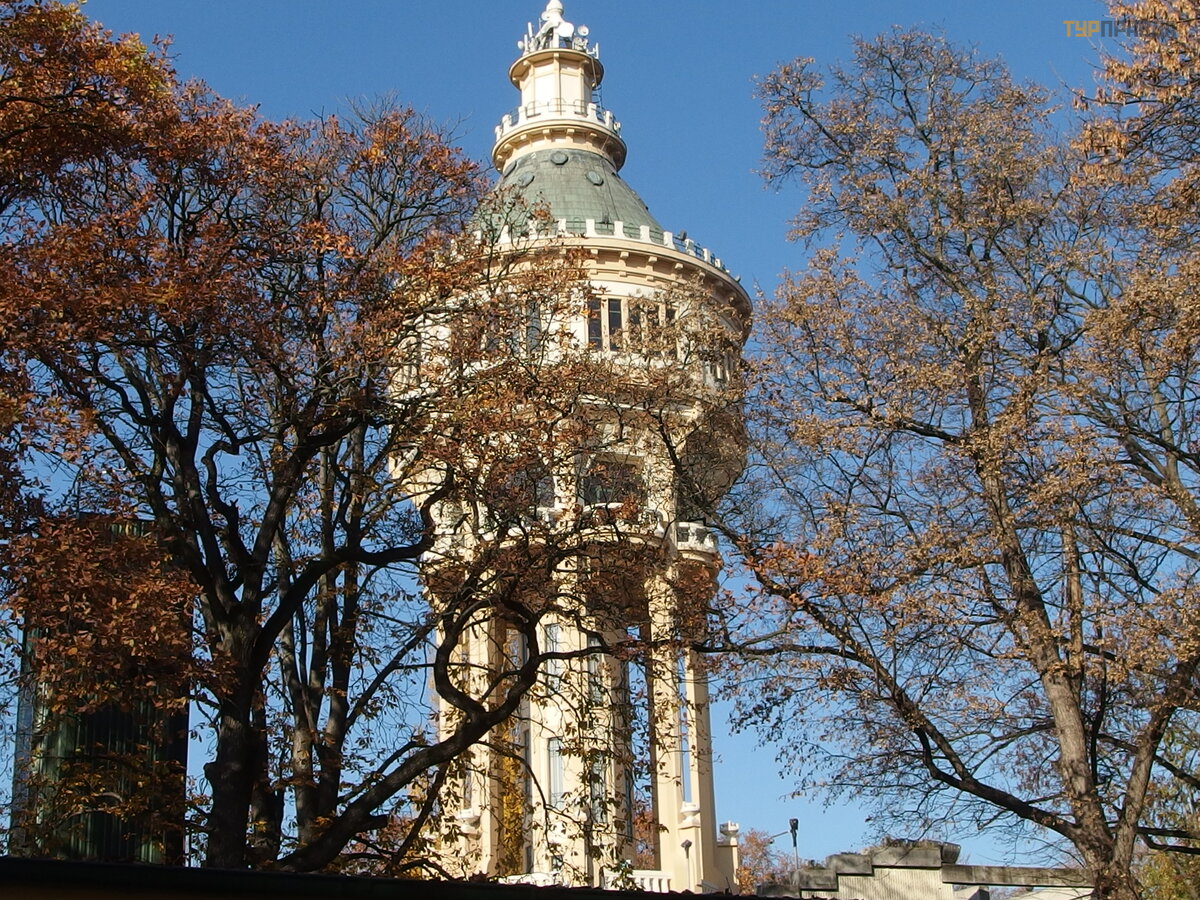
Поблизости с водонапорной башней находится открытый театр. В летнюю пору на его подмостках ставятся оперные спектакли. Немного севернее водонапорной башни протянулась Аллея деятелей искусства, которую еще называют Бульваром скульптуры. По обе стороны аллеи установлены бюсты венгерских художников, музыкантов и писателей.
Аллея деятелей искусства выводит к Гранд-отелю Danubius Grand который раньше назывался иначе – Grand-Margitsziget. Здание отеля было построено в 1872 году по проекту Миклоша Ибля. Рядом находится еще один отель – более современный «Термаль» (Margitsziget Thermal) оборудованный термальными купальнями.
Прогуливаясь по Аллее деятелей искусств, можно увидеть расположенную поблизости церковь Святого Михаила.
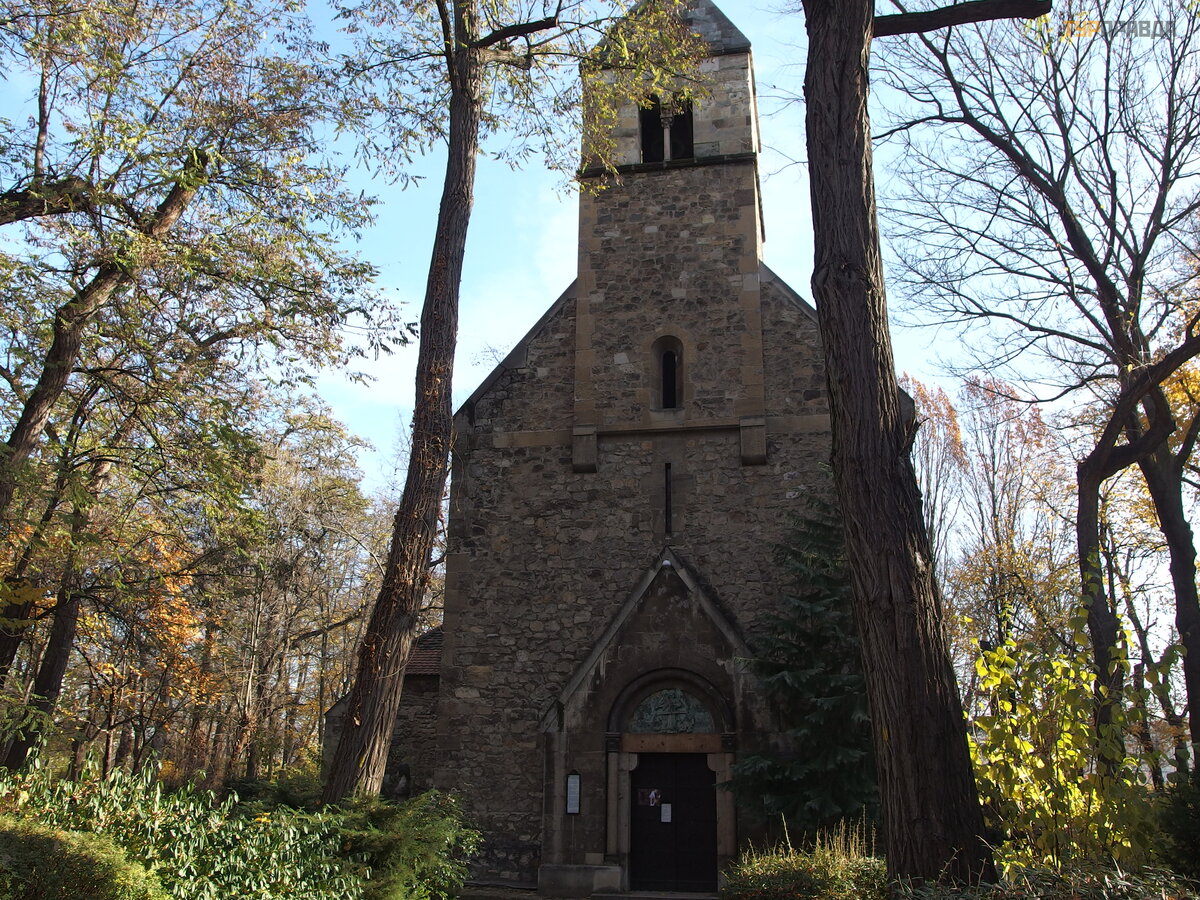
Она была построена из камней, которые остались от ранее располагавшегося на этом месте доминиканского монастыря. В 1930 году церковь восстановили по фрагментам, которые сохранились после 1541 года, когда турки уничтожили монастырь. В церкви находится колокол, датированный 15 веком.
На острове произрастает большое количество охраняемых видов растений. Среди наиболее редких стоит упомянуть гинкго билоба.
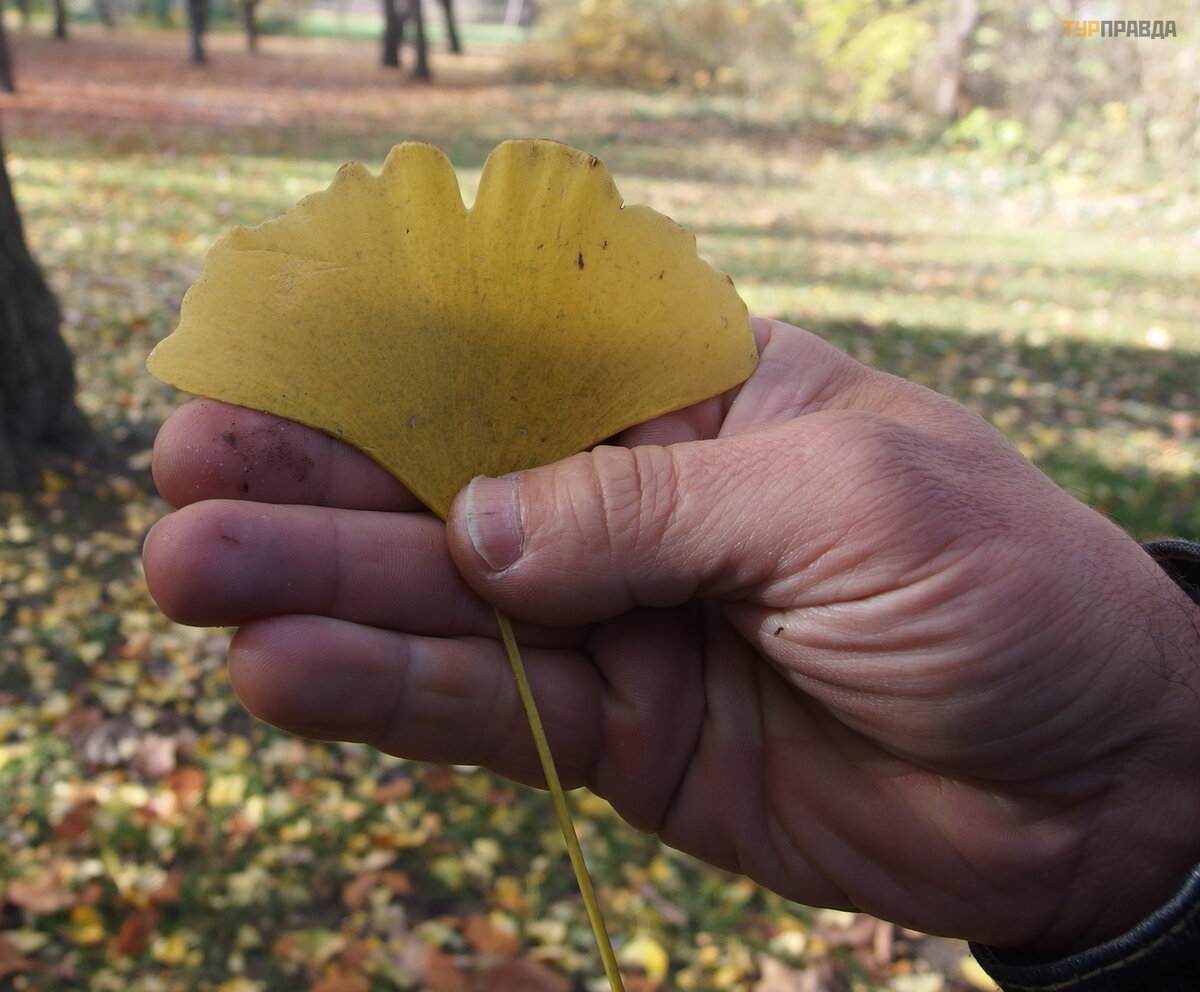
Имеется на острове, с правой стороны, примерно в середине, и небольшой бесплатный зоопарк (Margitszigeti allatkert), где обитают 117 видов млекопитающих и птиц: олени, пони, зайцы, домашние и дикие птицы и многие другие. Летом можно войти внутрь зооуголка, покататься на пони, выпить кофе. Разрешается кормить животных специальным кормом, купленным в буфете. Зимой вход в зоопарк закрыт.
Рядом с летним театром расположен замечательный Японский садик. Он был создан еще при главном садовнике Дьерде Мадьяре. Здесь, в окружении тенистых деревьев, вы увидите небольшое озеро с лотосами, услышите успокаивающий плеск ручейков и водопадов, полюбуетесь живописным альпинарием, мостиками и прочие декоративными атрибутами восточного садика. Главное, конечно, – это разнообразные японские растения. В горячем источнике скалистого сада можно увидеть сохранившиеся с конца 19 века остатки букового дерева. Водопад подпитывается водой из источника Жигмонди.
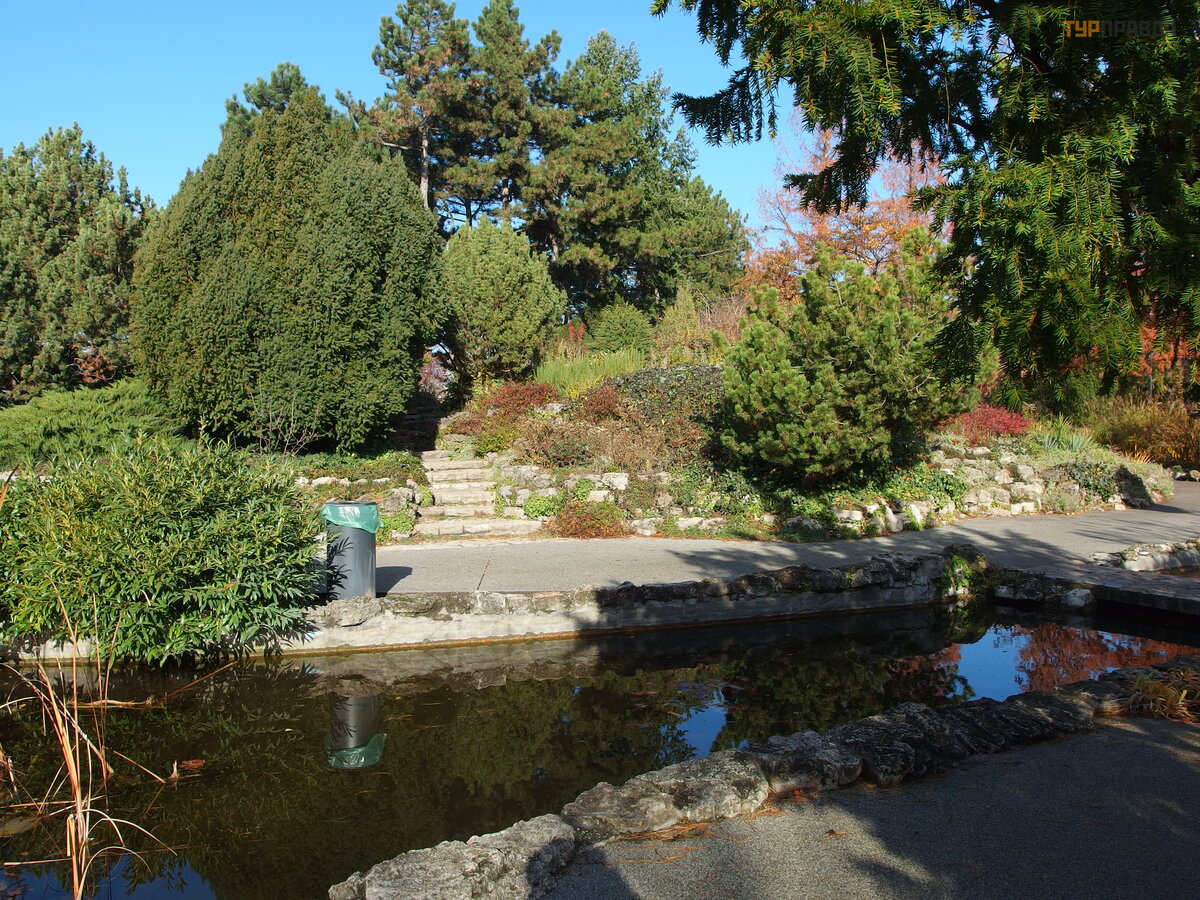
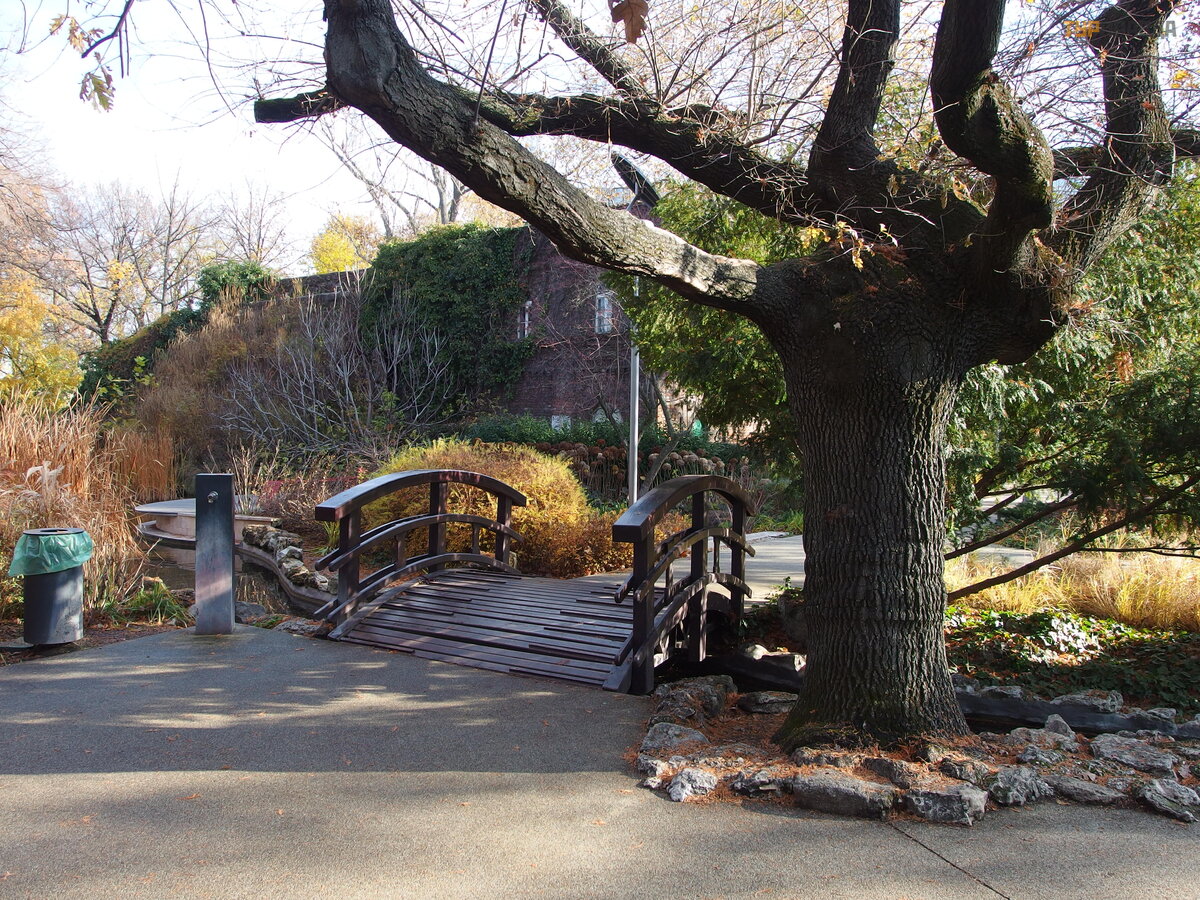
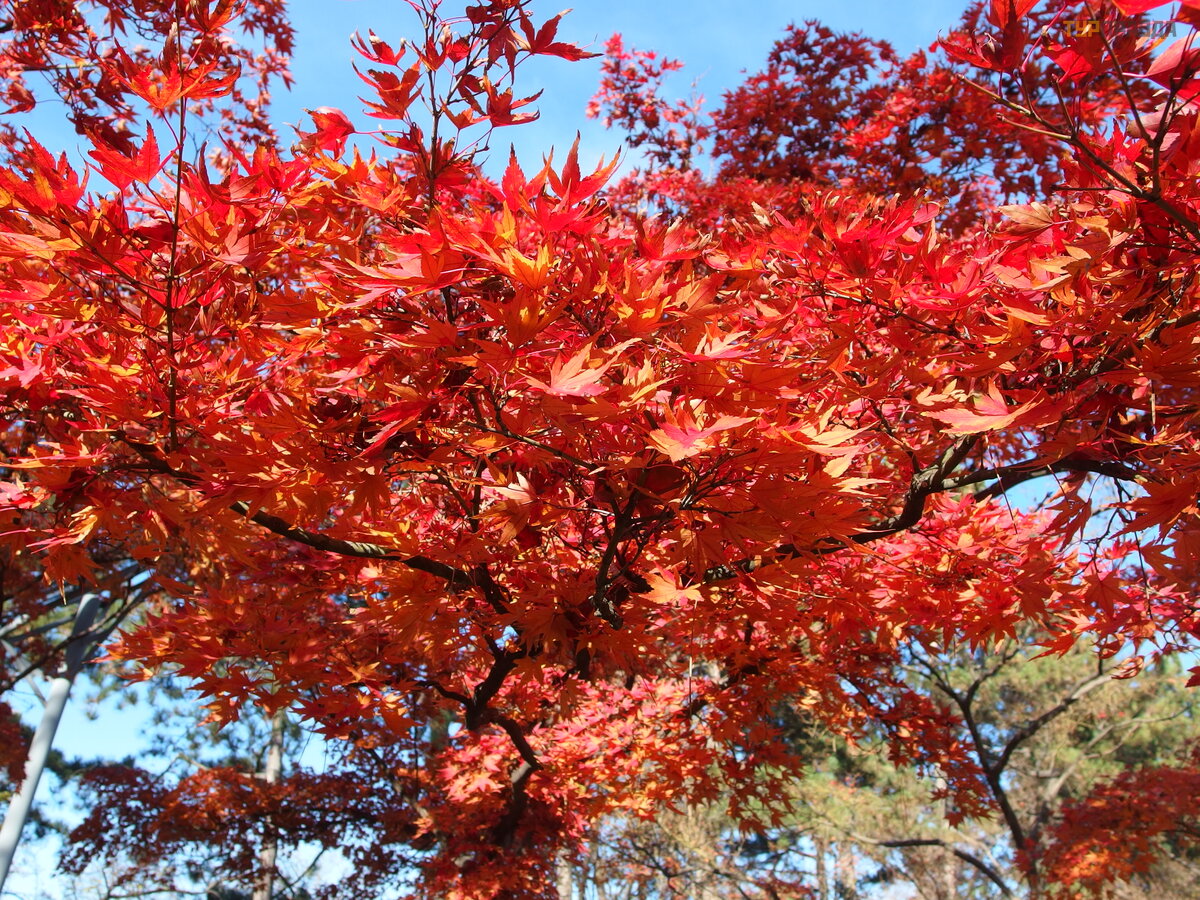
Немного далее вы обнаружите маленький павильон, известный как Музыкальный колодец. Построенный в 1936 году, он является точной копией колодца, построенного в Румынии трансильванским архитектором Петером Бодором в 1820 году. Его использовали для воспроизведения музыки, во время звучания которой наверху павильона начинала кружиться статуя Нептуна. К сожалению, механизм был поврежден во время Второй мировой войны.
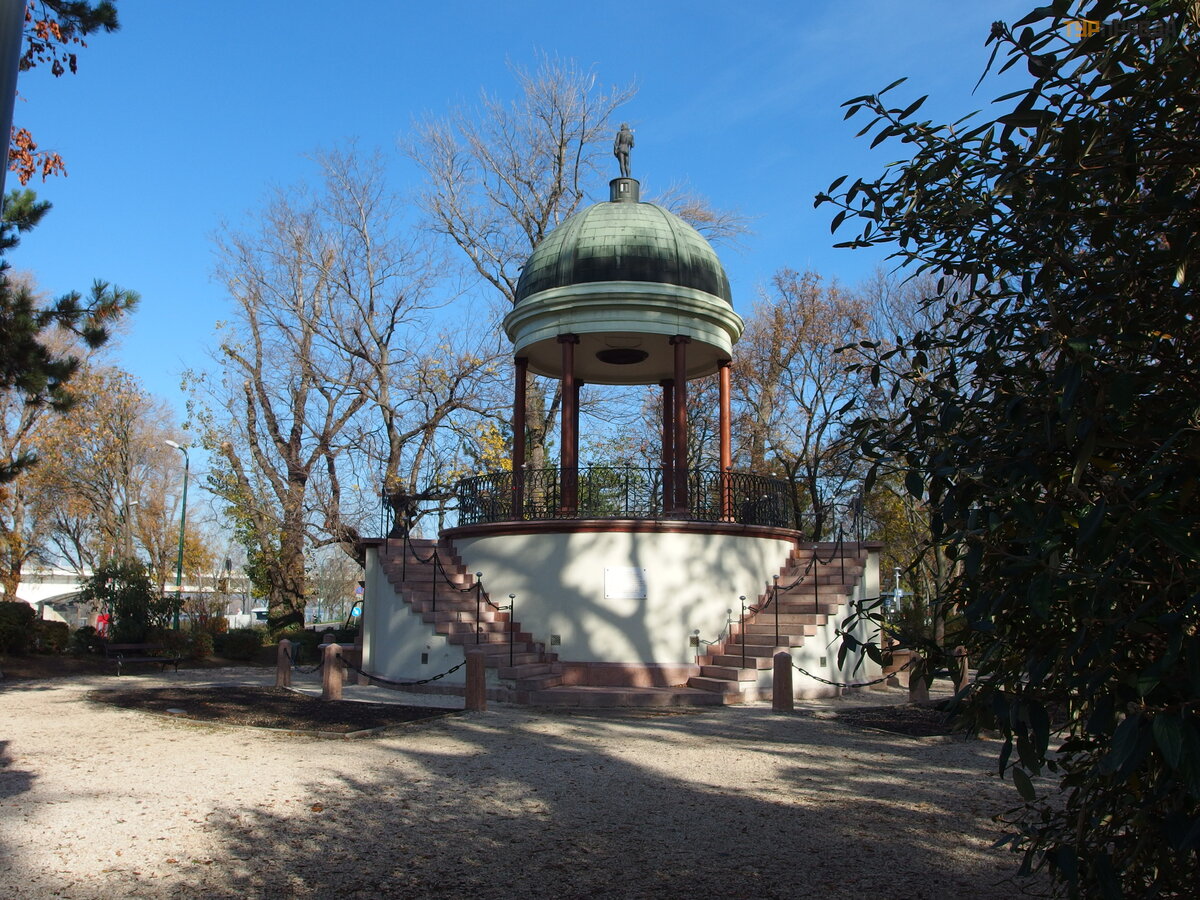
Далее наш путь лежит через мост Арпада в Обуду (Óbuda) – древний и самостоятельный город, вплоть до 1873, когда произошло объединение с Пештой и Будой. После объединения Обуда получил статус района столицы. Название Обуда на означает Старая Буда. И до XIII века он и был Будой, а ещё раньше – Аквинкумом.
Историческая справка: Первые поселения на территории Обуды появились ещё в каменном веке. Римляне поселились здесь в I веке до н. э., оценив по достоинству местные горячие источники. Они построили здесь город Аквинкум – столицу провинции Паннония. В Обуде сохранилась стела Веспасиана (I века н. э.)
Во II веке город был разрушен варварами, отстраивался, терпел осады, и в конце концов, был завоёван гуннами, от которых в V веке получил имя «Буда» – в честь брата короля Аттилы. Согласно «Песни Нибелунгах», на этом месте был легендарный Замок Аттилы (Etzelnburg). Впоследствии, на какое-то время, город утратил своё значение и был разрушен. Венгерские племена пришли сюда из Карпат около 900 года и воевода Арпад вдохнул новую жизнь в старое пепелище.
В 1241-1242 годах Буда была разрушена полчищами хана Батыя. После их ухода, в 1247 году, король Белла IV выстроил мощную крепость к югу от свежих руин. Поселение, выросшее вокруг Будайской твердыни, и стало в дальнейшем именоваться «Будой». А старое поселение за городскими стенами получило название Обуда. Впервые слово «Obuda» употребил в 1290 году король Андраш ІІІ.
В период турецкого владычества все центральные города Венгрии вступили в полосу культурного и экономического упадка.
С 1695 года и на протяжении почти всего XVIII века Обудой владел знатный род Зичи, построивший в 1746-1757 гг. барочный дворец на Главной площади (Fo tér). Сейчас в здании расположено три музея: Музей Лайоша Кашшака (художник-авнгардист и поэт 1915-1967), Музей Виктора Вазарели, Обудайский музей (хранит документы и предметы истории Обуды от римского периода до 20-го века, а также предметы быта и интерьера старых домов Обуды).
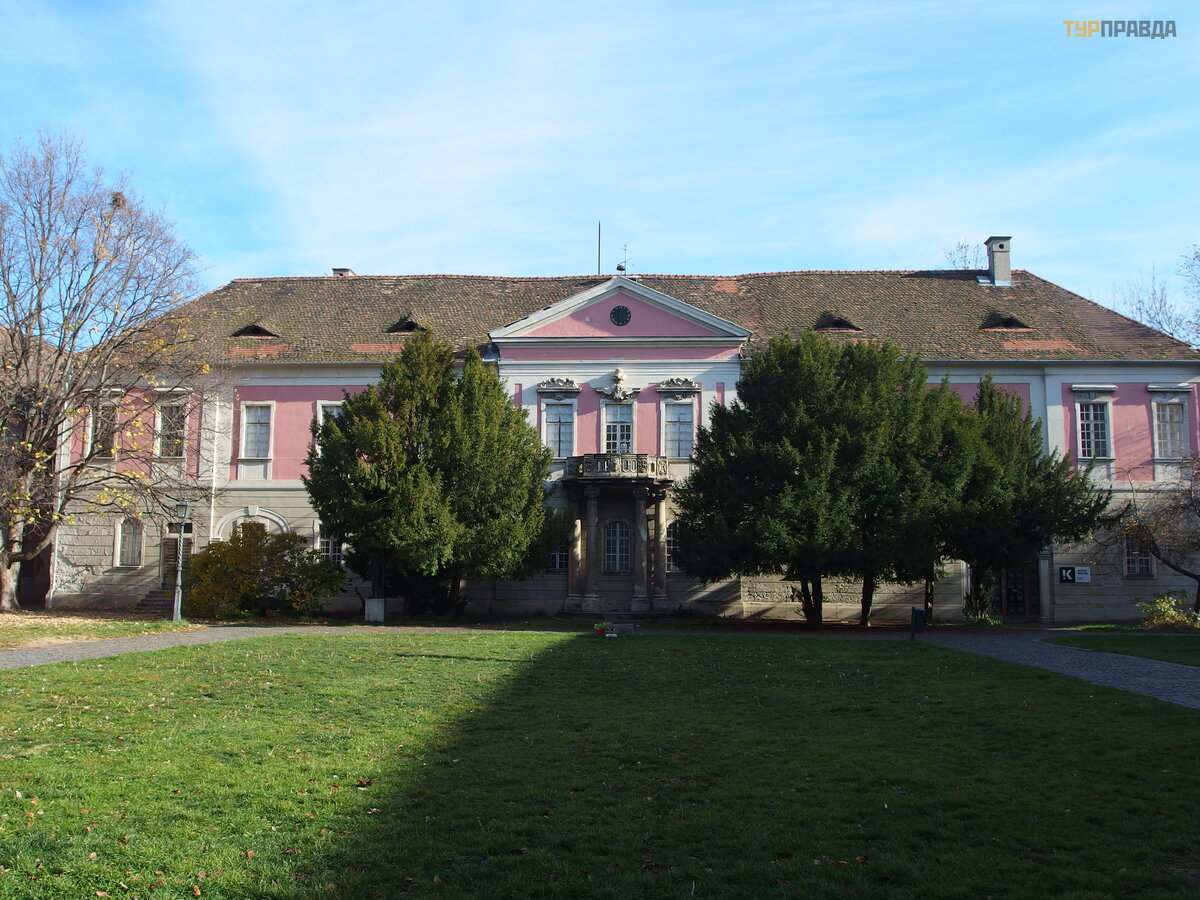
На противоположной стороне площади Фо-тер стоит изящное здание приходской церкви Св. Петра и Павла. Церковь также была построена на средства семьи Зичи и служила их фамильной усыпальницей.
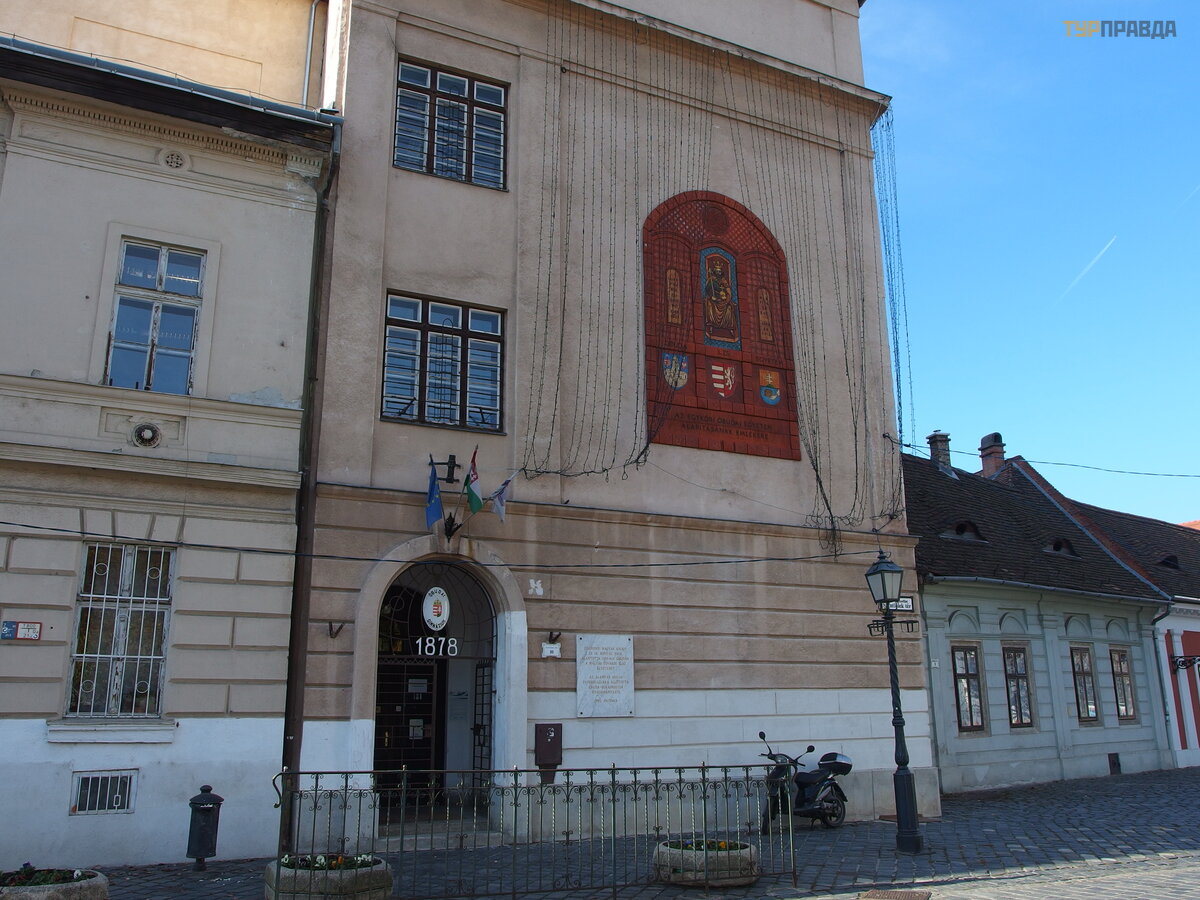
Поблизости расположено здание мэрии Обуды...
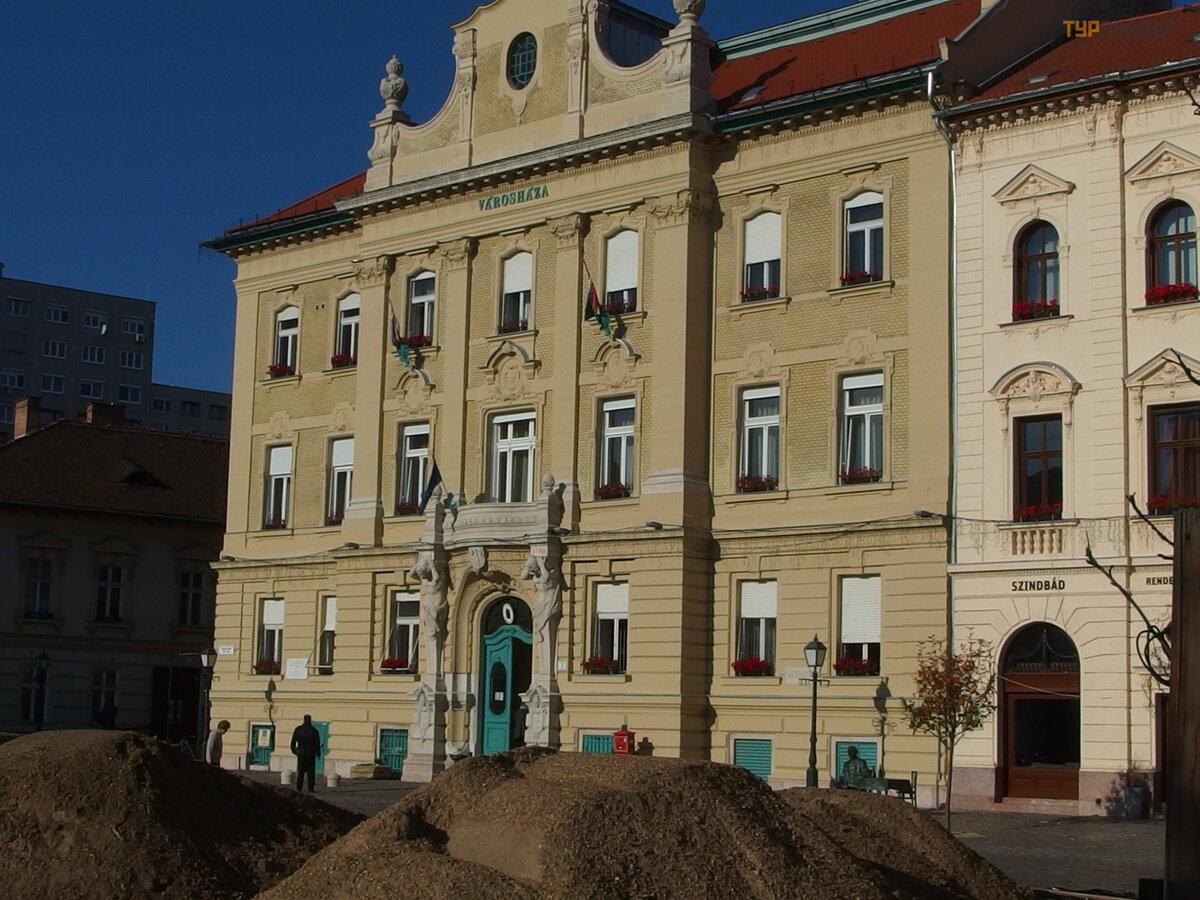
...и памятник первому и последнему мэру Обуды в 1873 году – Хареру Палу.
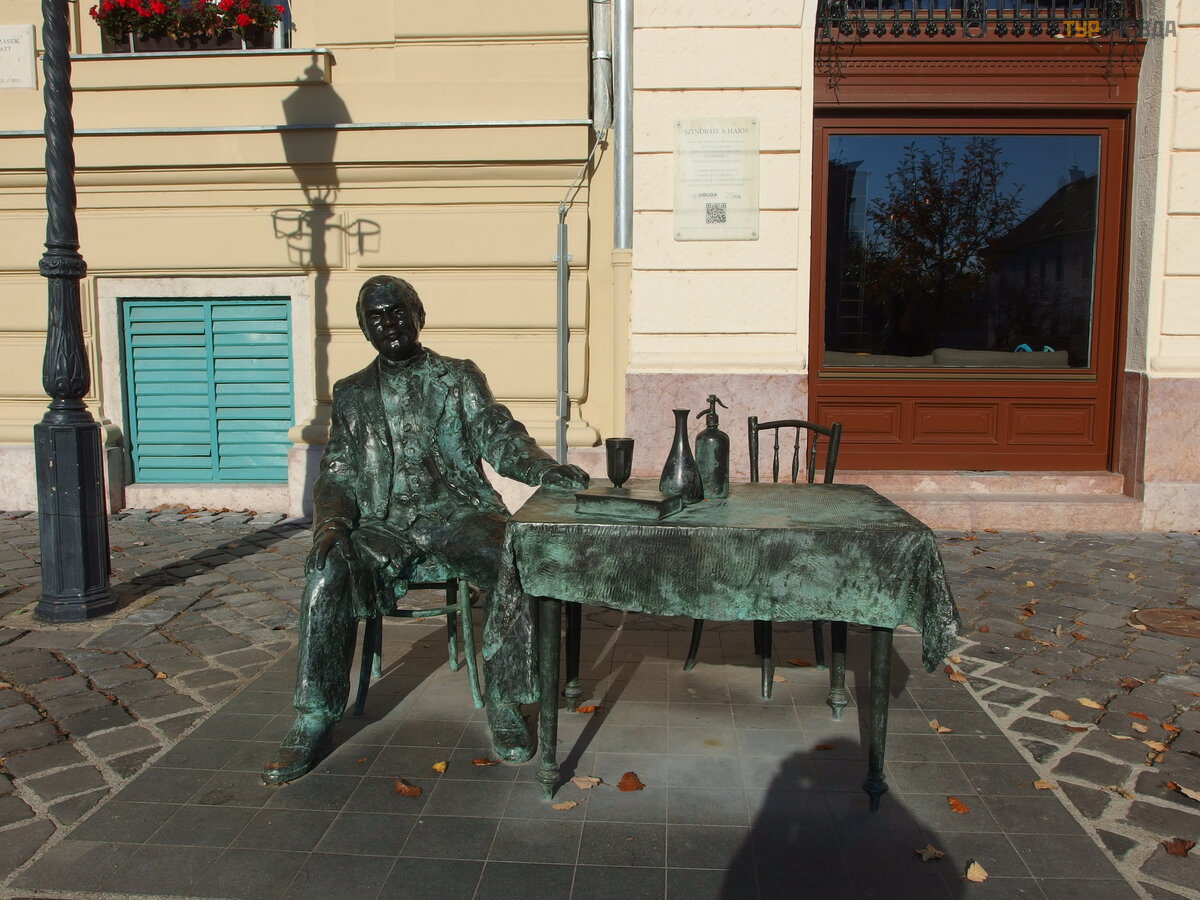
И еще здесь есть одна примечательная композиция "Гуляющие под дождем" венгерского скульптора Имре Варга. Она посвящена женам военных, которые ждут ушедших на фронт мужей.
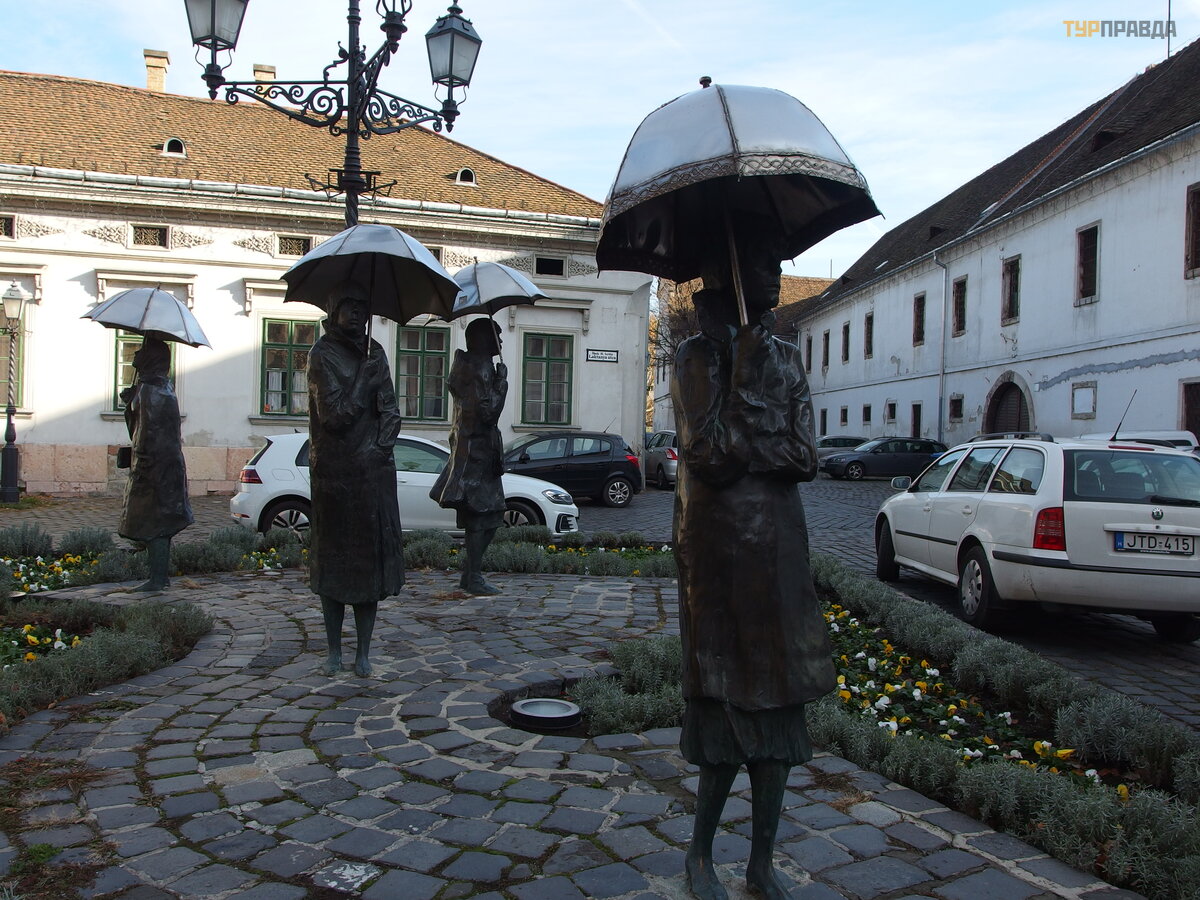
Свернув с шумной центральной улицы с пролетающими мимо автомобилями, ты неожиданно попадаешь в прошлое: на площади играют дети, старушки беседуют на лавочках, неспешно идут прохожие. Маленький кусочек старого Будапешта в окружении современного мегаполиса – площадь Фо-тер.
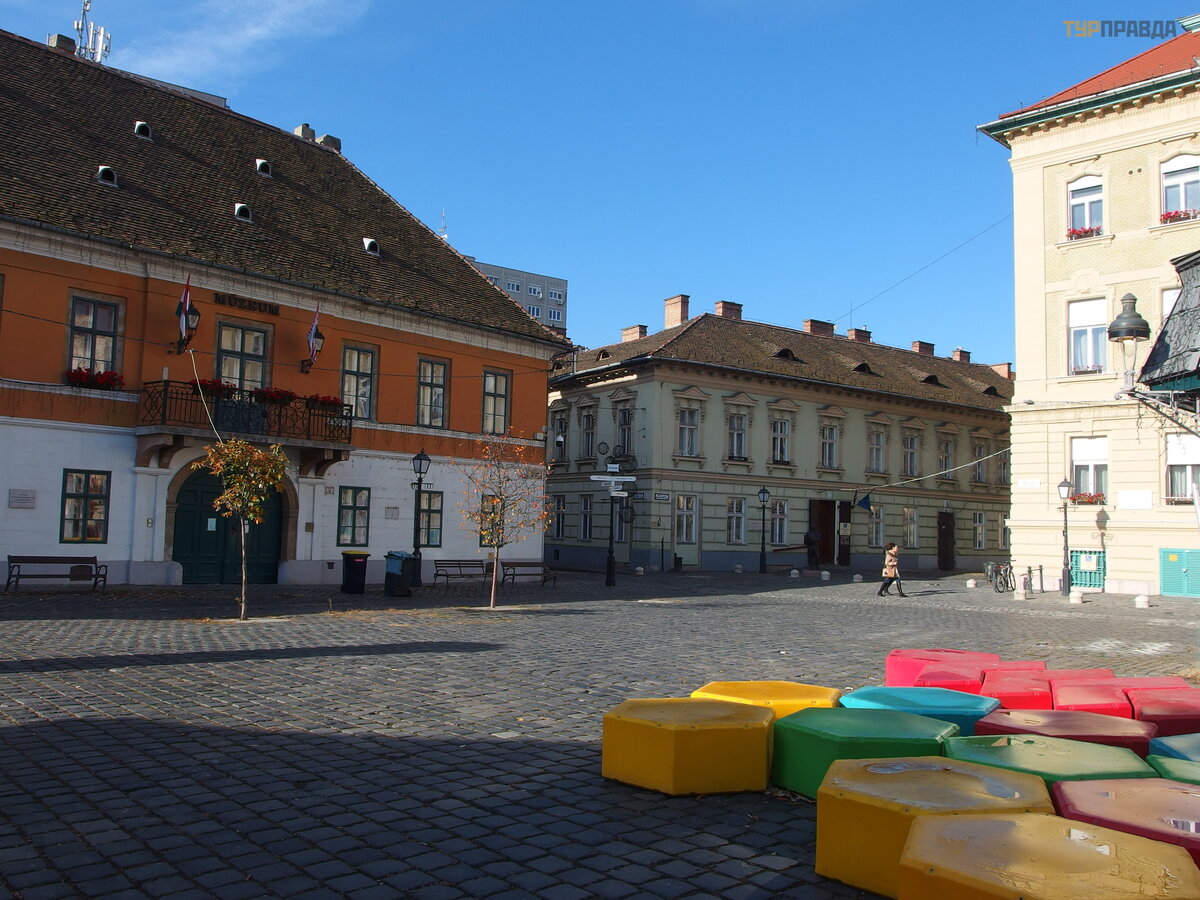
Далее посещение купальни Вели-бей (Veli bej fürd). Расположены они рядом с купальнями Лукач, но вход размещается со стороны Дуная.
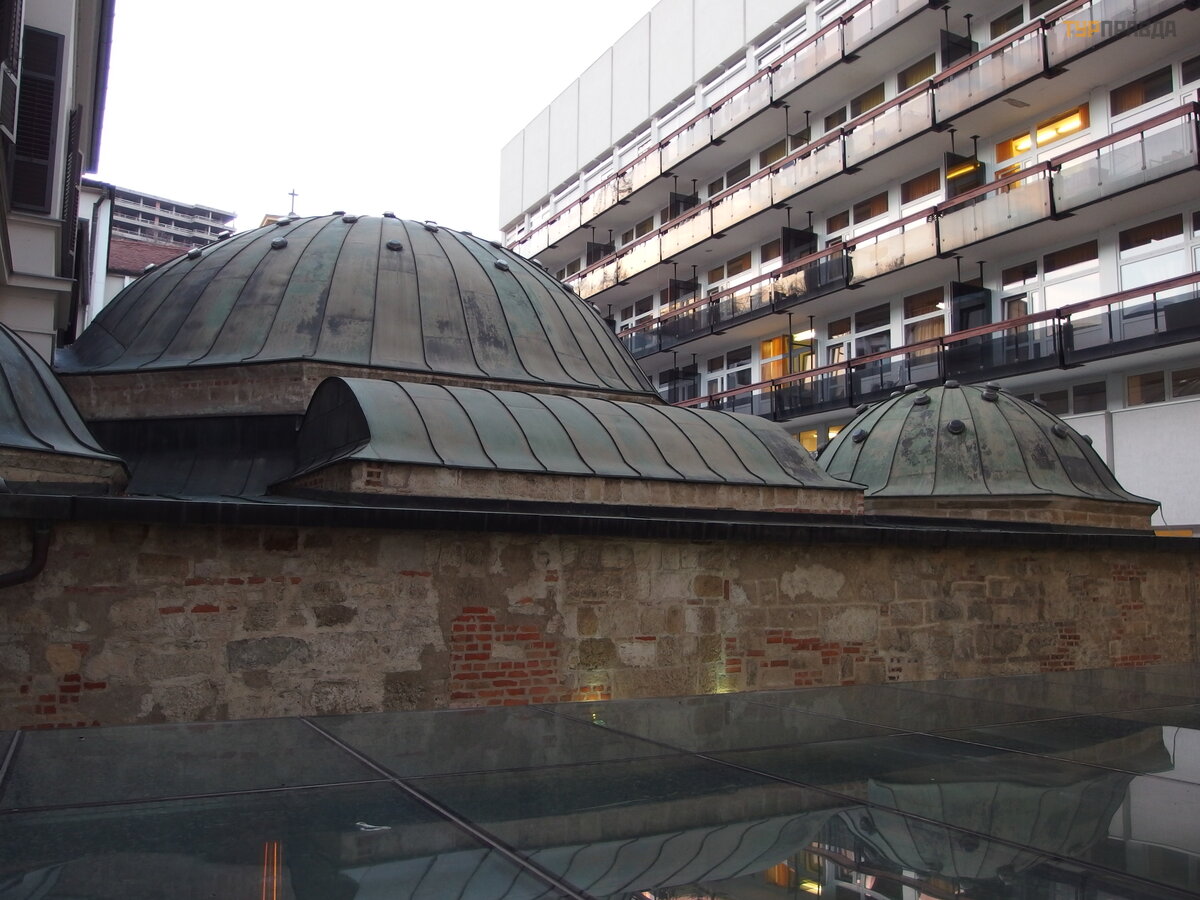
Историческая справка: Это одна из старейших купален Будапешта. История купальни «Вели Бей» берет свое начало еще в доримский период, а римляне уже регулярно пользовались для купания водами лечебных источников. Венгерский хронист Аноним (XII-XIII вв.) писал, что возглавлявший обретение родины венграми Арпад в 895-910 гг., перебравшись через Дунай, у Верхних горячих вод отдыхал после боев. Согласно датированной 1148 г. грамоте, на этом месте был Форум Тезы, т.е. место отдыха Тезы – короля Тезы II (1130-1162). Вершин своего расцвета местные купальни достигли в период турецкого нашествия (1526-1697 гг.). Во время захвата Будайской крепости турки не разрушали имевшиеся купальни. Наоборот, они расширяли их, добавляли к ним цветочные сады и парки. Паша Мохамед распорядился построить на холме возле купален (ныне Холм роз) усыпальницу святого Гюль-бабы, а купальни соединил с местами отшельничества дервишей. В XVI в. султан Сулейман и великий визирь Мустафа Соколи расширили и украсили купальню. Об этом свидетельствует выбитая на стене купальни надпись на турецком языке, которая в стихотворной форме описывает краткую историю купальни и с восторгом отзывается о ее красоте и чудотворных свойствах ее источников.
Эдвард Браун, известный английский врач XVII в., по поручению объединения королевских врачей объехавший почти всю Европу, в 1673 г. прибыл в Буду и так писал о купальне «Вели Бей»: «В Буде можно найти первоклассные купальни, я насчитал восемь таковых, в некоторых из них искупался. Самая красивая среди них – купальня Véli Bej, в украшение которой Сулейман вложил огромные средства. У купальни пять круглых куполов, центральный купол поддерживают 12 колонн». Действительно, эта купальня в определенной степени отличалась от традиционных купален того времени. После освобождения Буды (1686 г.) купальня «Вели Бей» вместе с другими купальнями перешла в собственность сокровищницы. Во времена правления Липота I Габсбурга, короля Венгрии (1657-1705), купальня была известна под названием Thermae Regiae Majoros. Затем ее выкупил у сокровищницы Янош Эггер. В первые годы XVIII в. купальня еще находилась в своем оригинальном состоянии, о чем свидетельствуют заметки и рисунок венского архитектора Фишера фон Эрлаха: «Купальню посещает много людей не только из-за ее полезной воды, но и из-за арабской архитектуры». В то время купальня уже называлась «Кайзер Бад», т.е., иными словами, купальня «Часар» («Часар» по-венгерски – «император»).
В 1804 г. совет наместничества поручил врачебной комиссии проверить лечебный источник купальни «Часар». После сделанного комиссией в 1806 г. заключения купальню «Часар» купил королевский советник Иштван Марцибаньи, и в качестве благотворительного пожертвования он передал ее будайскому ордену милосердия с условием, что доходы от купальни пойдут на содержание больных людей и монахов. В этот период купальня «Часар» была скромным небольшим заведением. В 1842 г. был построен большой лечебный двор с двумя пристроенными зданиями, в которых были 100 жилых комнат и 85 ванн. А парная баня купальни «Часар» была одним из первых подобных заведений Будапешта. Информационный бюллетень Венгерской бальнеологической ассоциации в 1933 г. писал, что купальня «Часар» может полностью заменить такие курорты, как Пиештяны, Баден, Баден-Баден, Висбаден, Аахен и Тренчанске-Теплице. В 1926 г. к купальне был пристроен плавательный бассейн. В 1965 г. купальня «Часар» перешла в ведение Всевенгерского института ревматологии и купального дела (позже: Всевенгерский институт ревматологии и физиотерапии), т.е. в ведение министерства здравоохранения. А с 2000 г. купальня вновь перешла под эгиду ордена милосердия.
Необходимые для лечения и процедур лечебные воды поступают сюда из артезианских скважин купальни «Лукач», а также находящегося на острове Маргит знаменитого источника «Магда». Купальня «Вели Бей» представляет собой, собственно говоря, скрытое сокровище, о существовании которого не подозревает большинство жителей Будапешта. Это объясняется многими причинами. Во-первых, в XIX в. здание было полностью окружено воздвигнутыми в тот период строениями, с улицы ею нельзя было увидеть. Во-вторых, в последнее время его использовали исключительно в лечебных целях, сюда не допускалась широкая публика. К тому же в последние годы его состояние настолько ухудшилось, что здание стояло заброшенным. В 2004 орден милосердия осуществил крупные инвестиции, начав работы по восстановлению здания. Здание и его окрестности предварительно были обследованы археологами. Их работы увенчались успехом! Были найдены оригинальные фрагменты пола, крашеные стены, старинные трубопроводы, посуда. Купальня обрела своё прежнее название, так что вместо названия «Купальня “Часар”» снова появилось – «Купальня “Вели Бей”».
Восьмиугольный бассейн обновленной купальни обладает уникальными особенностями. Температура воды составляет 36 градусов Цельсия, а ее течение очень стремительно: около 1200 л в минуту. В результате такой скорости течения вода в бассейне полностью обновляется четыре раза в день. Поэтому нет необходимости добавлять в нее хлор, воду отличает абсолютно естественная свежесть. Восьмиугольный бассейн окружают небольшие краны, под которыми могут наслаждаться водой посетители купальни, а в четырех углах разместились семейные бассейны с водой различной температуры: 16, 32, 34 и 40 градусов Цельсия. В окружающих купальню помещениях разместилось новое вэлнес-отделение: полноценному отдыху служат парные с двумя видами ароматических масел и с температурой 40 и 50 градусов Цельсия, финская сауна и инфрасауна, душевые кабины с массажными струями и ледяными чашами. К купальне относятся также джакузи, массажные и гидроксерные ванны, а также отделение гидротерапии. Это единственная турецкая купальня, в которой нет специальных дней посещения отдельно для мужчин и женщин, представители обоих полов могут купаться вместе. Это новое здание, имеющее тем не менее многолетнюю историю, и эта историческая атмосфера рождает незабываемые впечатления.
Официальный сайт – http://www.irgalmasrend.hu/site/velibej/home
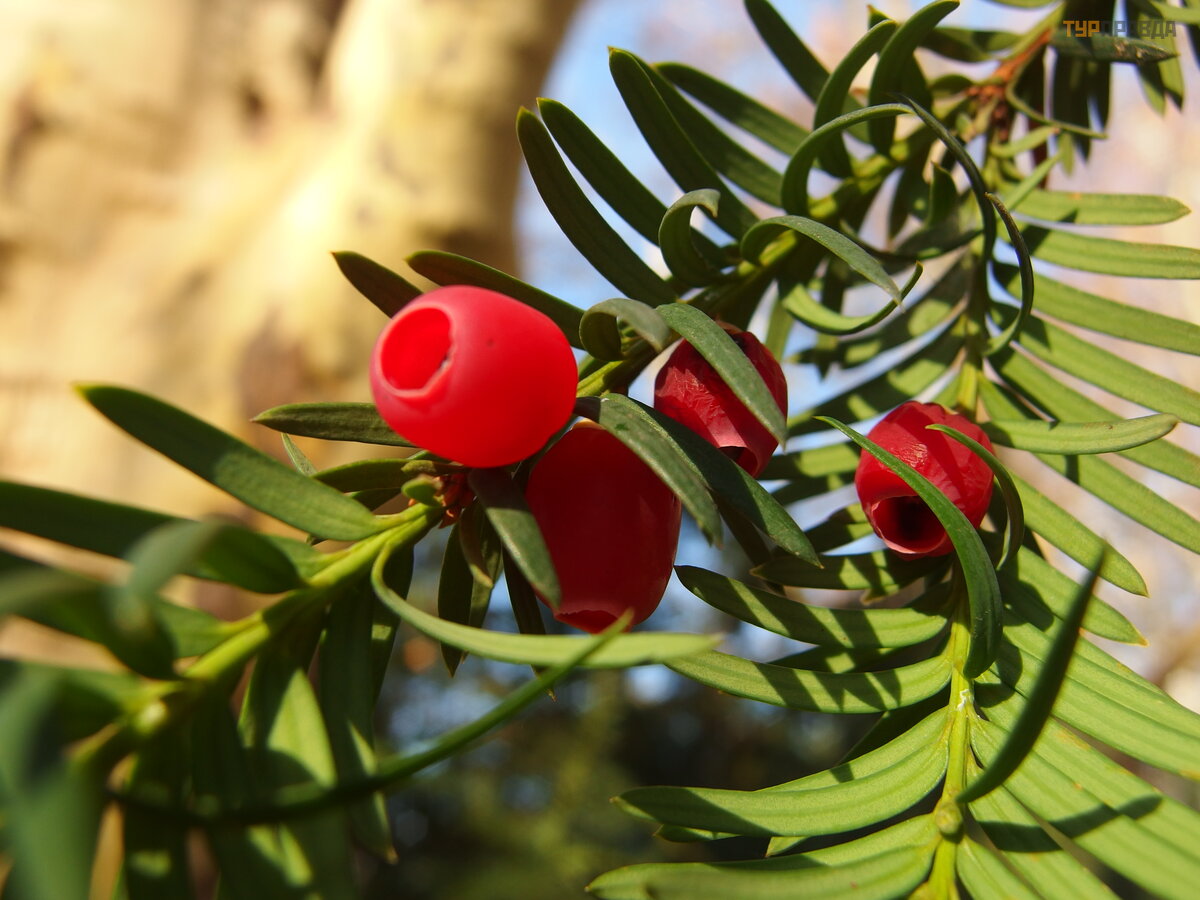
Продолжение https://www.turpravda.com/hu/budapesht/blog-484379.html

Seven colors of Budapest. The color is red. The color is orange. Home>>>
Seven Colors of Budapest. Continuation. Yellow>>>
Color green - park.
St. Stephen's Boulevard ( SzentIstvdn korui ), which is part of the Great boulevard ( Nagy kor ui ), half ring girded old Pest. This main avenue of the Hungarian capital, almost 4.5 km long, runs along the dried-up Danube riverbed. It was planned to be built in the second half of the XIX century, taking the example of the Ring Boulevard in Vienna. It was even proposed to dig an entire navigable canal, but this idea had to be abandoned due to excessive cost. Construction began in 1871 and lasted a quarter of a century.
The economic crisis and other difficulties hindered the implementation of a large-scale prank of the capital's authorities.
As a result, by 1883 only 23 houses had been built!
To attract investors, we had to take unprecedented measures, giving them preferential tax treatment. This allowed to move the process from a standstill, and the pace of construction has increased significantly. The scale of the construction is impressive, as the redevelopment affected a large area, where more than 200 buildings had to be demolished. The new city highway was pompously opened in 1896 during the millennium celebrations of the Hungarians' conquest of their new homeland. In 1887, the first tram in Budapest was launched here on one of the central sections of the boulevard (modern routes 4 and 6).
The boulevard near Margithid Bridge ( Margithid ) ends, construction of which began almost simultaneously with the boulevard ring.
The difficulty was that the city authorities wanted the future bridge not only to connect the two banks of the river, but also to have an exit to the island of Margaret (opposite the turn to the island is a balcony with a magnificent view of the Danube and coastal neighborhoods . )>

The French company won the tender for the construction of the bridge. This affected the exterior of the building, which resembled the bridges of Paris. Unfortunately, many design elements, including openwork wrought iron fences and lanterns, have not survived. Only the rosters of ships on the pillars are reminiscent of the former beauty. The bridge often had to be rebuilt, each time widening the carriageway to meet the needs of the city. After the war, it had to be rebuilt, because, like all other crossings, it was blown up by the Nazis. The last reconstruction began in 2009-2011.
During this time, it was planned not only to replace worn-out structures, but also to return the former design elements.
Many urban legends are connected with the Margaret Bridge. It became a favorite place of urban suicides, which inspired the poet Janos Aran to invent a ballad about suicide, illustrated by the famous artist Mikhail Zichi (was a court artist of the Russian court, illustrated works by Lermontov, Gogol, known for illustrations)).
 Тарас Бульба
Тарас Бульба
The artist's bust is installed on the island.
Margitsziget Island is a city park recognized as the most beautiful park in Budapest. Margaret Island consists of three small islands.
Before the northern side, which now abuts the Arpad Hid, was fortified, it moved slowly downstream. The length of Margaret Island is 2.5 km.
Initially, the area of Margaret Island was 58 hectares, today the island is 96.5 hectares, the largest width - 500 m. Previously, the island was at an altitude of 102.5 m above sea level, but due to frequent flooding it was raised by another 2 m. consists of pebble deposits, washed over the river for many years, was known by various names: the island of the lords, the hare's island, the island of St. Andras, the maiden's island, the island of Buda, the island of Palatinus, and others. in the 14th century thanks to the Dominican convent located on the island. The monastery and church were built by King Bela IV of Hungary for his daughter Margarita.
 Ruins of a Dominican monastery on the island
Ruins of a Dominican monastery on the island
As early as 1241, before the birth of his daughter (born in 1242), Bela IV vowed before the Almighty to give him his child to serve, if she would help repel the Mongol-Tatar attack and save the Hungarian people. Apparently, the god listened to the prayers of the king, as the invasion of enemies was repulsed. After returning to Hungary (the king was temporarily in Austria), Margarita was brought up by nuns. The girl was then only 9 years old. Within the walls of the Dominican monastery, she grew up, then became abbess. It is known that the nuns of this monastery led an extremely ascetic life. Unfortunately, Margarita died very early - at the age of 29. After her death, she was declared a saint, and later the island itself was named after the girl.
 The church and the associated monastery stood right on the east coast of the island.
The church and the associated monastery stood right on the east coast of the island.
The most preserved parts of the monastery buildings
In 1540 the monastery was abandoned by nuns who took with them the remains of St. Margaret. In 1541 the Dominican monastery was destroyed and looted by the Turks. It is known that they used the monastery walls to house the harem of Pasha… Almost the same: )))
In 1796 the island passed to the chamber (governor) Joseph (Joseph), who held this post for half a century. Joseph became famous as a great lover of gardens. He built a villa here for his wife, Russian Princess Alexandra Pavlovna, and laid out a park with a magnificent rosary. A young gardener, Karoi Tosht (he was only 20 years old), a native of the famous Schö nbrunn dynasty, was invited to decorate the island. Arriving in Hungary in 1810, Kara remained here forever. Much of what we have the opportunity to see today on Margaret Island is the work of his hands.
About 300 species of plants have been planted on the island at the Jozifi House.
In particular, the first plane trees were planted, which later took root on the island of Margaret and survived to this day.
 The same plane trees
The same plane trees
In 1869 the park was opened to the public. However, until 1908 it was allowed to visit only for entrance tickets. From 1882 the chief gardener of the island of Margaret was Gyö rgy Magyar (1844-1923). There is information that an incredible number of roses were grown on the island for commercial purposes: 1.400 varieties.

The park on the island of Margaret became a favorite vacation spot for locals in the second half of the 19th century. However, until 1901 the island could only be reached by river in boats and ships.
The Margarita Bridge was built in 1876 by French engineer Ernest Guin, but only a quarter of a century later a convention was added to the island.
The current appearance of the island of Margaret was mainly formed in the middle of the 19th century, but in the 20th century there were major changes. In particular, in 1911, new walking areas were created. After 1927.60, 000 cubic meters were processed during the creation of the park. m of land, made walking paths 6 thousand m long and 6 m wide. 150 ash trees were planted on the Pest side of the island, and 200 spruce trees on the Buda side. In addition to them, 3.000 other trees and 50.000 plants were planted. On the site of the garden center was laid a huge flower garden, covering an area of .15 thousand square meters. m!

Since 1866, when artesian healing waters were discovered while drilling a well, Margaret Island has become famous as a thermal resort.
The island received the official status of a sanatorium in 1929. Currently, there are three thermal springs with healing mineral water.
The central alley of the island begins in Margarita Bridge. A monument was erected here in 1972 to commemorate the 100th anniversary of the annexation of Buda and Pest and Obuda in 1873. This bronze monument, designed by Istvan Kiss, is two intertwined sheets.


Opposite the monument is a large "musical fountain", the jets of which are constantly changing size and shape. In the evenings, a real light and musical performance is played out: bright lighting is turned on to the music.
In the center of Margaret Island, to the right of the main alley, you can see one of the main local attractions - the ruins of the 14th century Franciscan church.
Not far from the ruins is the Villa Palatine Joseph. Rather, also ruins, as the villa was destroyed in 1838 due to floods.
In summer, the largest beach on the island of Budapest - "Palantinus".
Another attraction of Margaret Island is the 57-meter dome-topped water tower. It is visible from afar from different parts of the island. Exhibitions of contemporary art are held in the tower today.

There is an open-air theater near the water tower. In the summer, opera performances are staged. A little north of the water tower stretches the Alley of Artists, which is also called the Boulevard of Sculpture. Busts of Hungarian artists, musicians and writers are installed on both sides of the alley.
The Alley of Artists leads to the Grand Hotel Danubius Grand, formerly known as Grand-Margitsziget. The hotel building was built in 1872 by Miklos Ible. Nearby is another hotel - a more modern "Thermal" (Margitsziget Thermal) equipped with thermal baths.
Walking along the Alley of Artists, you can see the nearby Church of St. Michael.

It was built of stones left over from a former Dominican monastery. In 1930 the church was restored according to the fragments that survived after 1541, when the Turks destroyed the monastery. The church has a bell dating back to the 15th century.
The island has a large number of protected plant species. Among the rarest are ginkgo biloba.

There is a small free zoo (Margitszigeti allatkert) on the island, on the right side, about in the middle, where 117 species of mammals and birds live: deer, ponies, hares, domestic and wild birds and many others. In summer you can go inside the zoo, ride a pony, drink coffee. It is allowed to feed the animals with special food bought at the buffet.
In winter, the entrance to the zoo is closed.
Next to the summer theater is a beautiful Japanese garden. It was created under the chief gardener Gyö rgy Magyare. Here, surrounded by shady trees, you will see a small lake with lotuses, hear the soothing splash of streams and waterfalls, admire the picturesque rock gardens, bridges and other decorative attributes of the eastern garden. The main thing, of course, is a variety of Japanese plants. In the hot spring of the rock garden you can see the remains of beech trees, preserved from the late 19th century.
The waterfall is fed by water from the Zigmondi spring.



A little further you will find a small pavilion known as the Well of Music.
Built in 1936, it is an exact replica of a well built in Romania by Transylvanian architect Peter Bodor in 1820. It was used to play music, during the sound of which a statue of Neptune began to circle at the top of the pavilion. Unfortunately, the mechanism was damaged during World War II.

Then our path lies through the bridge of Arpad to Obuda (Ó buda) - an ancient and independent city, until 1873, when the union with Pest and Buda. After the unification, Obuda received the status of the capital's district. The name Obuda does not mean Old Buddha.
And until the XIII century he was Buddha, and even earlier - Aquincum.
Historical background: The first settlements in the territory of Obuda appeared in the Stone Age. The Romans settled here in the I century BC. They built the city of Aquincum, the capital of the province of Pannonia.
The ceiling of Vespasian (1st century AD) has been preserved in Obuda
In the II century the city was destroyed by barbarians, rebuilt, endured sieges, and eventually conquered by the Huns, from whom in the V century received the name "Buddha" - in honor of the brother of King Attila. According to the "Song of the Nibelungs", this place was the legendary Castle of Attila (Etzelnburg). Eventually, for a time, the city lost its significance and was destroyed. Hungarian tribes came here from the Carpathians around 900 and the voivode of Arpad breathed new life into the old fire.
In 1241-1242, the Buddha was destroyed by hordes of Khan Batu.
After their departure, in 1247, King Bella IV built a powerful fortress south of the fresh ruins. The settlement that grew up around the Buda Fortress was later called Buda. And the old settlement behind the city walls was named Obuda. The word Obuda was first used in 1290 by King Andrá s III.
During the Turkish rule, all central cities of Hungary entered a period of cultural and economic decline.
From 1695 and for almost the entire 18th century, Obudoi was owned by the noble Zichi family, who built a baroque palace on the Main Square (Fo té r) in 1746-1757. Currently, the building houses three museums: Lajos Kashshak Museum (avant-garde artist and poet 1915-1967), Victor Vasarely Museum, Obudai Museum (preserves documents and objects of history) Awakenings from the Roman period to the 20th century, and household items of the old houses of Obuda).

On the opposite side of Foter Square is the elegant building of the parish church of St. Peter and Paul. The church was also built at the expense of the Zichi family and served as their family.

The Obuda City Hall is nearby ...

and a monument to the first and last mayor of Obuda in 1873, Harer Palu.

And here is another wonderful composition by Hungarian sculptor Imre Varga, walking in the rain. It is dedicated to the wives of the military who are waiting for the men who went to the front.

Turning off the noisy main street with cars passing by, you suddenly fall into the past: children are playing in the square, old women are talking on benches, passers-by are walking slowly.
A small piece of old Budapest in the middle of a modern metropolis is Foter Square.

Next visit the Veli Bej Baths (Veli bej fü rd). They are located next to the Lukacs Baths, but the entrance is on the Danube side.

Historical background: This is one of the oldest baths in Budapest.
The history of the baths "Veli Bay" dates back to the pre-Roman period, and the Romans regularly used for bathing waters of healing springs. The Hungarian chronicler Anonymous (XII-XIII centuries) wrote that he led the conquest of the homeland by the Hungarians in Arpad in 895-910. ie, the place of rest of Thesis - King Thesis II (1130-1162). The peaks of the local baths reached their heyday during the Turkish invasion (1526-1697).
During the capture of the Buda Castle, the Turks did not destroy the baths. On the contrary, they expanded them, adding flower gardens and parks. Pasha Mohammed ordered the construction of the tomb of St. Gul-Baba on the hill near the baths (now the Hill of Roses), and combined the baths with the hermitages of the dervishes. In the XVI century. Sultan Suleiman and Grand Vizier Mustafa Sokoly expanded and decorated the baths.
This is evidenced by the inscription on the wall of the baths in Turkish, which in poetic form describes the short history of the baths and enthusiastically speaks of its beauty and miraculous properties of its springs.
Edward Brown, a famous English physician of the XVII century. On behalf of the Association of Royal Physicians, he traveled almost all of Europe, in 1673 Buddha arrived and wrote about the baths "Big Bay":
The most beautiful among them is the Vé li Bej bath, on the decoration of which Suleiman invested a lot of money. The bath has five round domes, the central dome is supported by 12 columns. In fact, this bath was somewhat different from the traditional baths of the time. After the liberation of Buda (1686), the Veli Bay Bath, along with other baths, became the property of the treasury. During the reign of Lipot I Habsburg, King of Hungary (1657-1705), the bath was known as Thermae Regiae Majoros.
Then it was bought from the treasury by Janos Egger. In the early years of the XVIII century. the bathhouse was still in its original state, as evidenced by notes and a drawing by the Viennese architect Fischer von Erlach: "The bathhouse is visited by many people not only because of its useful water, but also because of the Arab architecture. " At that time the bathhouse was already called "Kaiser Bad", ie, in other words, the bathhouse "Chasar" ("Chasar" in Hungarian - "emperor").
In 1804, the council of governors instructed the medical commission to check the therapeutic source of the bath "Clock". After his imprisonment by the commission in 1806, the Clock Bath was bought by the royal adviser Istvan Marcibanyi, and as a charitable donation he donated it to the Buddhist Order of Mercy on the condition that the proceeds from the bath go to the sick and monks. During this period, the Clock Bath was a modest small establishment. In 1842
a large medical courtyard was built with two outbuildings, which had 100 living rooms and 85 baths. The steam bath of the Clock Bath was one of the first such establishments in Budapest. A newsletter from the Hungarian Balneological Association in 1933 wrote that the Garlic Baths could completely replace resorts such as Piestany, Baden, Baden-Baden, Wiesbaden, Aachen and Trenchansk-Teplice. In 1926 a swimming pool was added to the baths. In 1965
Chasar Bath was transferred to the All-Hungarian Institute of Rheumatology and Bathing (later: All-Hungarian Institute of Rheumatology and Physiotherapy), ie to the Ministry of Health. And since 2000, the baths have again come under the auspices of the Order of Mercy.
The healing waters needed for treatment and procedures come here from the artesian wells of the Lukach baths, as well as the famous Magda spring on the island of Margit.
The Veli Bay Baths are, in fact, a hidden treasure that most Budapest residents are unaware of. This is due to many reasons. First, in the nineteenth century. the building was completely surrounded by buildings built during the period, it could not be seen from the street. Secondly, recently it has been used exclusively for medical purposes, the general public was not allowed here.
In addition, in recent years its condition has deteriorated so much that the building was abandoned. In 2004, the Order of Mercy made major investments, starting work to restore the building. The building and its surroundings were previously surveyed by archaeologists. Their work was a success! Original fragments of the floor, painted walls, ancient pipes, utensils were found. The bath has found its former name, so instead of the name "Bath Garlic" reappeared - "Bath" Veli Bay ".
The octagonal pool of the renovated swimming pool has unique features. The water temperature is 36 degrees Celsius, and its course is very rapid: about 1200 liters per minute. Due to this speed of flow, the water in the pool is completely renewed four times a day. Therefore, there is no need to add chlorine to it, the water is characterized by completely natural freshness.
The octagonal pool is surrounded by small taps, under which visitors can enjoy the baths, and in the four corners are family pools with water of different temperatures: 16.32, 34 and 40 degrees Celsius. A new wellness area is located in the surrounding baths: steam rooms with two types of aromatic oils and a temperature of 40 and 50 degrees Celsius, a Finnish sauna and infrasauna, showers with massage jets and ice bowls.
The spa also includes a jacuzzi, massage and hydro baths, and a hydrotherapy department. This is the only Turkish bath, which does not have special days of visits separately for men and women, both sexes can bathe together. This is a new building with a long history, and this historic atmosphere creates an unforgettable experience.
Official site - http:// www. irgalmasrend. hu / site / velibej / home
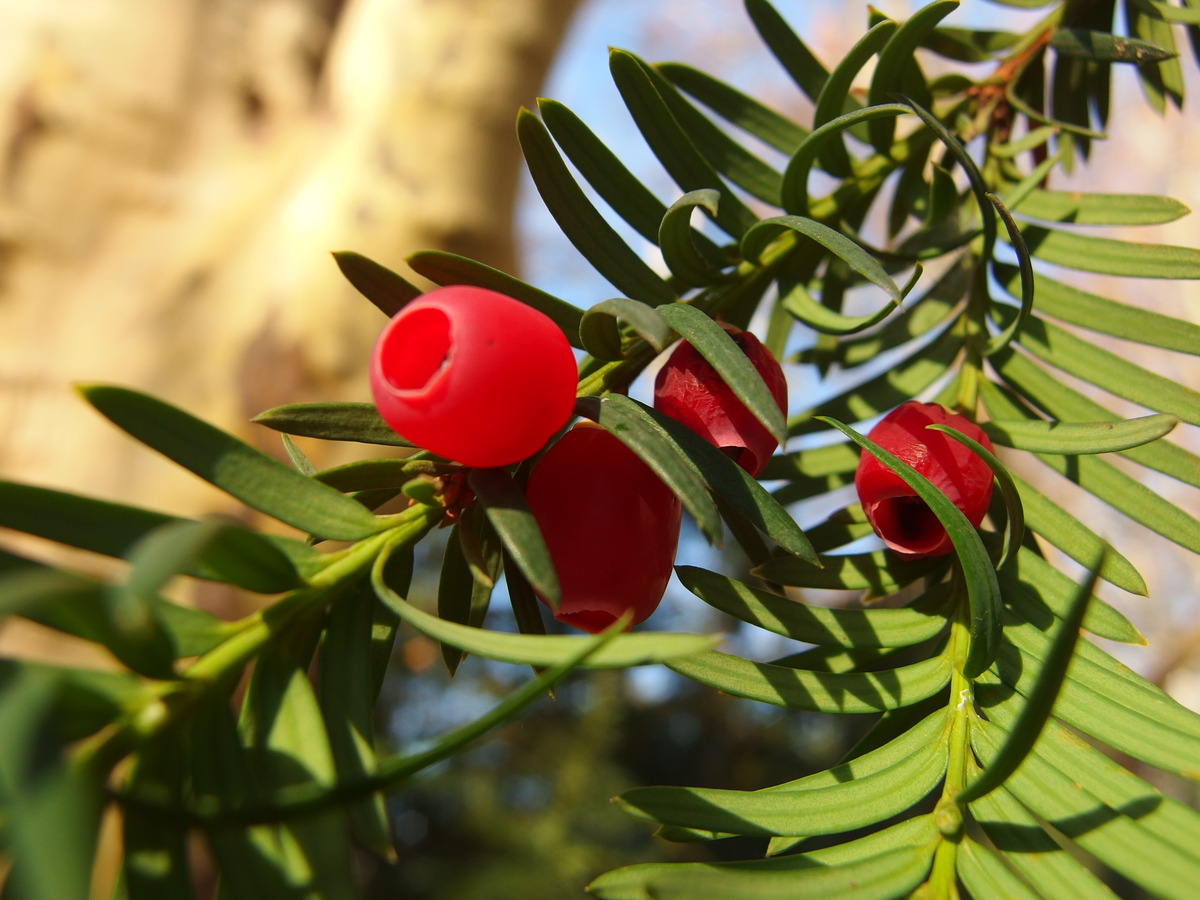
Continued https://www.turpravda.com/hu/budapesht/blog-484379 .html
Ruins of a Dominican monastery on the island
 The church and the associated monastery stood right on the east coast of the island.
The church and the associated monastery stood right on the east coast of the island.







































































